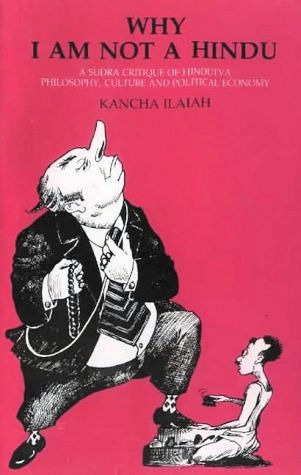
Abb.: Einbandtitel
[Fair use]
|
Gastvortrag an den Universitäten Würzburg und Tübingen am 2010-12-15
von
Zitierweise:
Payer, Margarete <1942 - >: Einführung in Hindutva. -- URL: http://www.payer.de/indienchronik/Hindutvavortrag.htm
Erstveröffentlichung: 2020-12-16
Überarbeitungen:
Copyright: Creative Commons Lizenz - Verfasserangabe - Weitergabe unter gleichen Bedingungen (CC-BY-SA 3.0)
Beim Vortrag über https://zoom.us/ habe ich PowerPoint Folien benutzt. Im Folgenden Text sind diese in den Text eingearbeitet.
Meine Ausführungen stammen aus meiner laufenden Arbeit. Erwarten sie also bitte keine endgültigen Antworten. Ich gebe Ihnen einige Puzzle-Stückchen, die Sie im Laufe Ihres Studiums immer mehr zu einem Gesamtbild ergänzen sollten. Die zitierten Texte klingen teilweise sehr extremistisch. Ich will damit keine Schwarzweißmalerei machen. Es gibt viele Zwischentöne, auf die ich hier nicht eingehen kann. Nach den Erfahrungen in Europa sollte man sich aber vor Verharmlosung hüten.
In seinem sehr lesenswerten Buch
Kancha Ilaiah Shepherd [Telugu కంచ ఐలయ్య] <1952 - >: Why I am not a Hindū : A Sudra critique of Hindutva philosophy, culture and political economy. -- Kolkata : Samya, 1996. -- 132 S.

Abb.: Einbandtitel
[Fair use]
Schreibt der Autor, Angehöriger einer Schäferkaste Südindiens:
"Introduction
I was born in a small South Indian Telangana village in the early 1950s and grew up in the 1960s. Our villages had undergone all the turbulence of the freedom movement as they were part of a historical struggle known as the Telangana Armed Struggle. [...]Suddenly, since about 1990 the word ‘Hindutva’ has begun to echo in our ears, day in and day out, as if everyone in India who is not a Muslim, a Christian or a Sikh is a Hindu. Suddenly I am being told that I am a Hindu. I am also told that my parents, relatives and the caste in which we were born and brought up are Hindu. This totally baffles me. In fact, the whole cultural milieu of the urban middle class—the newspapers that I read, the T.V. that I see—keeps assaulting me, morning and evening, forcing me to declare that I am a Hindu. Otherwise I am socially castigated and my environment is vitiated. Having been born in a Kurumaa (shepherd caste) family, I do not know how I can relate to the Hindu culture that is being projected through all kinds of advertising agencies. The government and the state themselves have become big advertising agencies. Moreover the Sangh Parivar harasses us every day by calling us Hindus. In fact, the very sight of its saffron-tilak culture is a harassment to us.
The question before me now is not whether I must treat Muslims or Christians or Sikhs as enemies, as the Hindutva school wants me to do. The question is: What do we, the lower Sudras and Ati-Sudras (whom I also call Dalitbahujans), have to do with Hinduism or with Hindutva itself? I, indeed not only I, but all of us, the Dalitbahujans of India, have never heard the word ‘Hindu’—not as a word, nor as the name of a culture, nor as the name of a religion in our early childhood days. We heard about Turukoollu (Muslims), we heard about Kirastaanapoollu (Christians), we heard about Baapanoollu (Brahmins) and Koomatoollu (Baniyas) spoken of as people who were different from us. Among these four categories, the most different were the Baapanoollu and the Koomatoollu. There are at least some aspects of life common to us and the Turukoollu and Kirastaanapoollu. We all eat meat, we all touch each other. With the Turukoollu, we shared several other cultural relations. We both celebrated the Peerila festival. Many Turukoollu came with us to the fields. The only people with whom we had no relations, whatsoever, were the Baapanoollu and the Koomatoollu. But today we are suddenly being told that we have a common religious and cultural relationship with the Baapanoollu and the Koomatoollu. This is not merely surprising; it is shocking."
[a.a.O., S. XIIIf. -- Fair use]
"Ich wurde in einem kleinen Dorf im südindischen Telangena in den frühen 1950er Jahren geboren und wuchs dort in den 1960er Jahren auf. Unsere Dörfer haben all die Unruhen der Freiheitsbewegung erlebt. Denn sie waren Teil des historischen Kampfes, der als bewaffneter Kampf Telanganas bekannt ist. [...]
Plötzlich, ungefähr seit 1990, hallte das Wort "Hindutva" in unseren Ohren, tagein - tagaus, so als ob jeder in Indien, der nicht ein Muslim, Christ oder Sikh ist, ein Hindū wäre. Plötzlich sagte man mir, ich sei ein Hindū. Man sagte mir auch, dass meine Eltern, Verwandten und die Kaste, in der wir geboren sind, Hindū wären. Das verblüfft mich völlig. Das ganze kulturelle Milieu der Mittelklasse - die Zeitungen, die ich lese, das Fernsehen, das ich schaue - greift mich ständig an - morgens und abends - und zwängt mich, zu erklären, dass ich ein Hindū bin. Andernfalls werde ich sozial gebrandmarkt und meine Umwelt ist beschmutzt. Da ich in einer Kurumā-Familie (Schäfer-Kaste) geboren wurde, weiß ich nicht, wie ich einen Bezug haben sollte zu der Hindū-Kultur, die jede Sorte von Werbeagenturen projiziert. Regierung und Staat selbst sind große Werbeagenturen geworden. Darüberhinaus belästigt uns der Sangh Parivar [Organisationen-Familie] täglich, indem er uns Hindūs nennt. In der Tat, der bloße Anblick der Saffran-Stirnzeichen-Kultur ist für uns eine Belästigung.
Vor mir steht nun die Frage, ob ich Muslime, Christen oder Sikhs als Feinde betrachten muss, wie es die Hindutva-Schule von mir verlangt. Die Frage ist: Was haben wir, die niedereren Shūdras und Ati-Shūdras (die ich auch Dalitbahujāns nenne), mit Hinduismus oder gar mit Hindutva zu tun? Ich - freilich nicht nur ich, sondern alle von uns, den Dalitbahujāns Indiens - wir haben in unseren frühen Kindheitstagen nie das Wort "Hindū" gehört - nicht als Wort, nicht als Namen einer Kultur, noch als Namen einer Religion. Wir hörten von Turukūlu (Muslimen), wir hörten von Kirastānapūlu (Christen), wir hörten von Bāpanūlu (Brahmanen) und Kūmatūlu (Baniyas - Vaiśyas), wenn man über Leute sprach, die von uns verschieden sind. Unter diesen vier Kategorien waren die am von uns unterschiedlichsten die Bāpanūlu (Brahmanen) und Kūmatūlu (Baniyas - Vaiśyas). Es gibt wenigstens einige Aspekte im Leben, die wir mit den Turukūlu (Muslimen) und Kirastānapūlu (Christen) gemeinsam haben: wir alle essen Fleisch und berühren uns gegenseitig. Mit den Turukūlu (Muslimen) hatten wir einige weitere kulturelle Beziehungen gemeinsam. Wir beide feierten das Pīrila-Fest. Viele Turukūlu (Muslimen) kamen mit uns auf die Felder. Die einzigen Leute, mit denen wir keinerlei Beziehung hatten, waren die Bāpanūlu (Brahmanen) und Kūmatūlu (Baniyas). Das ist nicht nur erstaunlich. Es ist schockierend."
Diese Worte eines Dalit, eines Outcast, eines Unberührbaren, sollten sie bitte im Folgenden immer im Hinterkopf haben. Nur so verstehen sie Hindutva in seinem vollen Umfang.
Vor diesem Hintergrund ist für unsere Zwecke
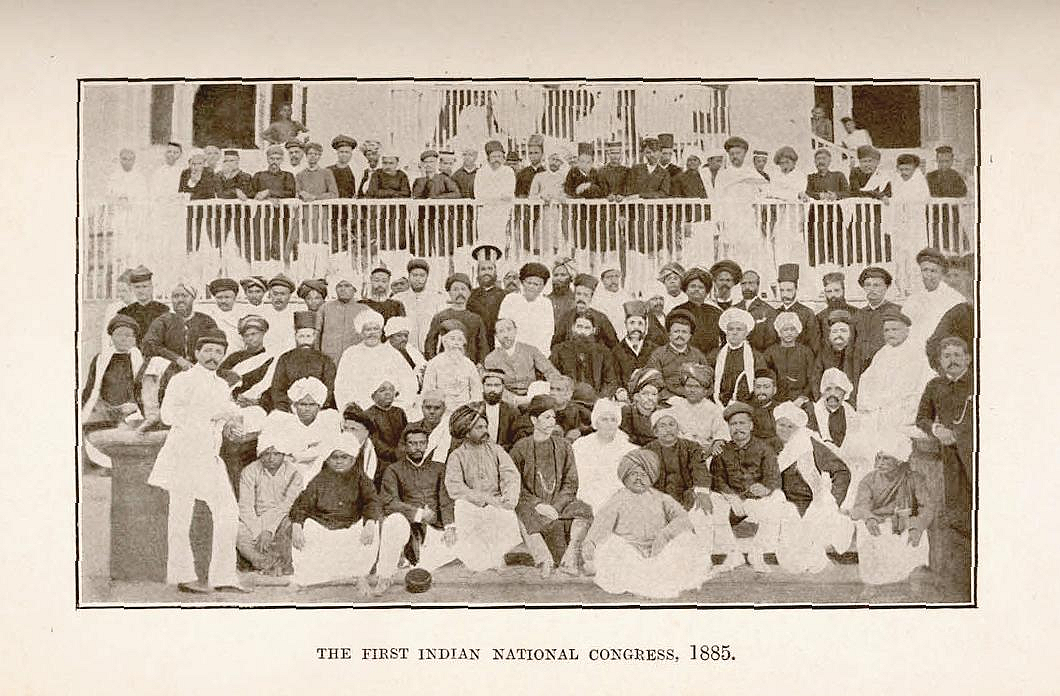
Abb.: First Indian National Congress, 1885
[Public domain]
Am 28. Dezember 1885 wurde in Bombay der Indian National Congress (INC) gegründet, der später zur wichtigsten Organisation der indischen Unabhängigkeitsbewegung wird und nach der Unabhängigkeit lange Zeiten die wichtigste politische Kraft. Initiator des Nationalkongresses war der britische Beamte des Indian Civil Service Allan Octavian Hume (1829 - 1912). Die Mitglieder des INC waren in keiner Weise repräsentativ für Indien. Doch dies soll uns hier nicht interessieren. Wir fragen uns aber, was heißt in "Indian National Congress" "National".
Das Wesen dieses Begriffs hat Max Weber (1864 - 1920) in seinem nach seinem Tod 1921/22 fragmentarisch herausgegebenen Werk "Wirtschaft und Gesellschaft" bleibend gültig beschrieben:
"»Nation« ist ein Begriff, der, wenn überhaupt eindeutig, dann jedenfalls nicht nach empirischen gemeinsamen Qualitäten der ihr Zugerechneten definiert werden kann. Er besagt, im Sinne derer, die ihn jeweilig brauchen, zunächst unzweifelhaft: dass gewissen Menschengruppen ein spezifisches Solidaritätsempfinden anderen gegenüber zuzumuten sei, gehört also der Wertsphäre an. Weder darüber aber, wie jene Gruppen abzugrenzen seien, noch darüber, welches Gemeinschaftshandeln aus jener Solidarität zu resultieren habe, herrscht Übereinstimmung. " [Quelle: Max Weber <1864 - 1920>: Wirtschaft und Gesellschaft. -- 1921/1922. -- Kapitel VIII, § 5: Nation. -- Online: Weber, Max, Grundriß der Soziologie, Wirtschaft und Gesellschaft, Zweiter Teil. Die Wirtschaft und die gesellschaftlichen Ordnungen und Mächte, Kapitel VIII. Politische Gemeinschaften, § 5. Die »Nation« - Zeno.org]
Leider hielt man sich in Indien eher an die Definition des Oxford New English Dictionary aus dem Jahr 1908, dem damals maßgeblichen Wörterbuch des britischen Englisch. Darin finden wir als Definition:
"Nation [...] 1. An extensive aggregate of persons, so closely associated with each other by common descent, language, or history, as to form a distinct race or people, usually organized as a separate political state and occupying a definite territory.
In early examples the racial idea is usually stronger than the political; in recent use the notion of political unity and independence is more prominent."
[Quelle: A New English Dictionary on Historical Principles: Founded Mainly on the Materials Collected by the Philological Society / by James A. H. Murray. -- Vol. 6, Part 2. -- Oxford : Clarendon, 1908. -- S. 30. -- Online: A New English Dictionary on Historical Principles: Founded Mainly on the Materials Collected by the Philological Society : James A. H. Murray : Free Download, Borrow, and Streaming : Internet Archive]"Nation ist eine ausgedehnte Gesamtheit von Personen, die eng miteinander verbunden sind durch gemeinsame
- Abstammung
- Sprache
- oder Geschichte
- So, dass sie eine gesonderte Rasse oder Volk bilden,
- normalerweise organisiert als politischer Staat
- und ein abgegrenztes Territorium besetzen.
In frühen Sprachbeispielen wird normalerweise die rassische Idee mehr betont als die politische; im neueren Gebrauch ist der Begriff politischer Einheit und Unabhängigkeit maßgeblicher"
In diesem Sinne ist es sehr schwer, eine indische Nation zu erkennen:
Die französische Wahlinderin Sāvitrī Devī (geborene Maximiani Portas, 1905 - 1982) hat dies klar gesehen in ihrem Buch "A Warning to the Hindūs", das 1939 in Kalkutta erschienen ist. Dieses Buch hatte einen großen Einfluss auf einen der Hauptvertreter der Hindutva Ideologie, Vināyak Dāmodar Sāvarkar (Marathi: विनायक दामोदर सावरकर, 1883 - 1966)
"Secondly, it is through Hinduism alone that one can realise India's unity, as a territory and as a civilisation. So many different provinces, which are, each one, large enough and different enough from one another to be separate nations. So many different languages, each one with its own evolution, its literature and its pride. So many different sceneries, and different climates, including both equatorial and polar.
But, broadly speaking, one type of society, one common civilisation; the same festivities, the same sacred language, the same places of pilgrimage within the limits of the same great India."
Savitri Devi [= Maximiani Portas] <1905 - 1982>: A Warning to the Hindus. -- Calcutta : Hindu Mission, 1939. -- 154 S. -- Online: https://archive.org/details/AWarningToTheHindus. -- Zugriff am 2018-04-13. -- Mit einem Vorwort von Ganesh Damodar Savarkar (Marathi: गणेश दामोदर सावरकर, 1879 – 1945), dem Bruder von Vinayak Damodar Savarkar (Marathi: विनायक दामोदर सावरकर, 1883 - 1966).
"Zweitens kann man nur durch Hinduismus die Einheit Indiens als Territorium und Zivilisation realisieren.
Es gibt so viele unterschiedliche Provinzen, von denen jede einzelne groß und von den anderen verschieden genug ist, um gesonderte Nationen zu sein.
Es gibt so viele unterschiedliche Sprachen, jede mit ihrer eigenen Entwicklung, ihrer eigenen Literatur und ihrem eigenen Stolz.
So viele unterschiedliche Landschaften, so viele unterschiedliche Klimata, einschließlich äquatorialen und polaren Klimas."
Deshalb stellt sie als Nationalistin das Postulat auf (es ist nur ein ideologisches Postulat, keine Beschreibung der Wirklichkeit):
"Aber es gibt, grob gesagt, einen Typ von Gesellschaft; eine gemeinsame Zivilisation; die gleichen Feste; die gleiche heilige Sprache (nämlich Sanskrit), die gleichen Pilgerorte innerhalb der Grenzen desselben Groß-Indien."
Das Problem für ALLE indischen Nationalisten war und ist die Frage nach der Einheit innerhalb dieser enzyklopädischen Vielfalt.
Die wichtigsten Antworten:
Schauen wir uns nun einige wichtige Schritte, Stufen und Entwicklungen der Hindutva-Ideologie, der Ideologie des Hindutums an.
Ein sehr wichtiges Ereignis für das Hindū-Selbstbewusstsein ist die Rede 1893-09-11 von Vivekānanda (Bengali বিবেকানন্দ, 1863 -1902) vor dem World Parliament of Religions (1893-09-11/27) anlässlich der Weltausstellung in Chicago. Der Erfolg des Frauenschwarms Vivekānanda in den USA bewirkt in Hindukreisen weitreichenden Triumphalismus.

Vivekananda (Bengali
বিবেকানন্দ, 1863 -1902)
[Public domain]
Gleichzeitig entsteht in der Hindī/Hindūstānī spechenden Region Nordindiens ein Hindī-Hindū-Nationalismus. Ausgedrückt z.B. vom Hindī-Schriftsteller Pratāp Narāyan Mishra (Hindī: प्रतापनारायण मिश्र, 1856 –1894) (leider konnte ich das Hindī Original nicht finden):
"If you truly desire your own welfare
then keep chanting this mantra with one tongue, hindī, hindū, hindustān
whether it attracts or repels the world, brings respect or affront
don’t leave off chanting with one voice, hindī, hindū, hindustān
those who don’t know their own identity are like the living dead
so sing loud this grand mantra, hindī, hindū, hindustān
wise are those who don’t discard their own language, food and clothing
in all its proof of good fortune, hindī, hindū, hindustān."[Übersetzung: Dalmia, Vasudha <1947 - >: The nationalization of Hindu traditions : Bhāratendu Hariścandra and nineteenth-century Banaras. -- 3rd impr. (©1997). -- Ranikhet : Permanent Black, 2017. -- 490 S. -- ISBN 817824304-0. -- S. 27. -- Fair use]
"Wenn Ihr wirklich Euer eigenes Wohlergehen ersehnt, dann singt ständig einstimmig dieses Mantra: Hindī, Hindū, Hindustan.
Gleichgültig, ob es die Welt anzieht oder abstößt, ob es Respekt oder Beleidigung bringt,
Hört nie auf einstimmig zu singen: Hindī, Hindū, Hindūstān
Wer seine eigene Identität nicht kennt, ist wie ein lebender Toter.
Deshalb singt laut dieses großartige Mantra: Hindī, Hindū, Hindūstān.
Weise sind die, die ihre eigene Sprache, ihre Nährweise und Kleidung nicht verwerfen,
Welche ein Beweis großen Vermögens sind. Hindī, Hindū, Hindūstān."
Bis dahin war indischer Nationalismus noch weitgehend von europäischen Ideen bestimmt. Doch 1895 ist sozusagen die Geburtstunde eines nativistischen Hindunationalismus:
Am 19 Februar 1895 organisiert Bāl Gangādhar Tilak (Marathi: बाळ गंगाधर टिळक, 1856 - 1920) erstmals Geburtstagsfeierlichkeiten von Shivājī Mahārāj (Marathi छत्रपती शिवाजीराजे भोसले, 1630 - 1680), dem kämpferischen Anführer der Marāthen und siegreichen Gegner des muslimischen Großmoghuls Aurangzeb (1618 - 1707) (Persisch: ابو المظفر محيى الدين محمد اورنگزيب بهادر عالمگير).
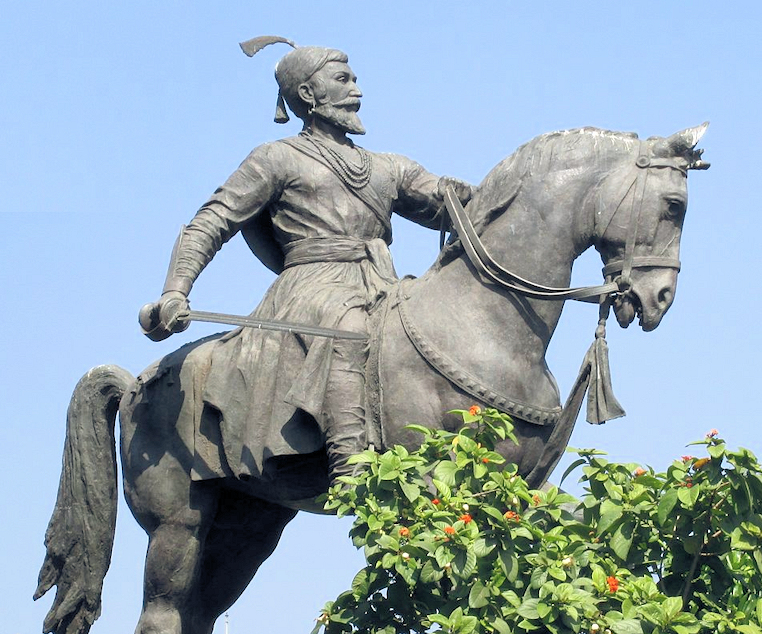
Abb.: Shivaji-Denkmal am
Gateway of India, Mumbai, 1980
[Bildquelle: Amit20081980/Wikimedia. --
CC BY-SA 3.0]
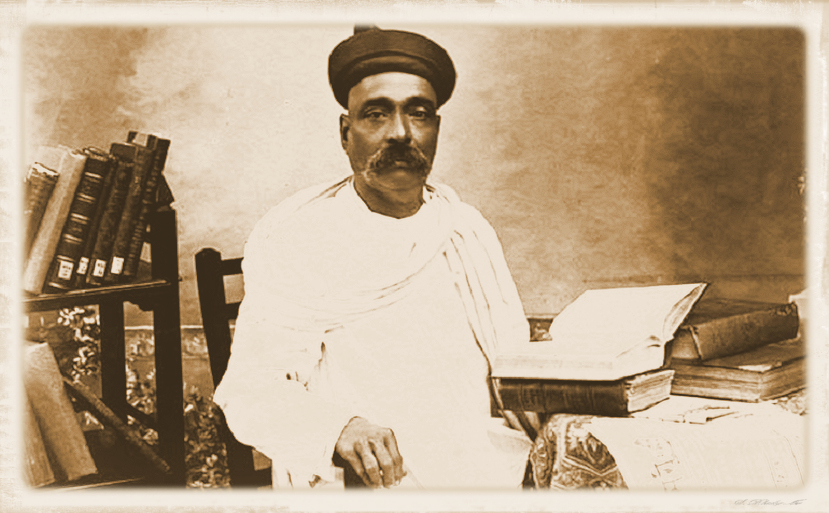
Abb.: Bal Gangadhar Tilak
[Public domain]
Seither gilt Shivājī in Hindu-Nationalistenkreisen als Vorkämpfer der Unabhängigkeit Indiens gegen Fremdherrschaft
Zur gleichen Zeit entstehen vielerorts Kuh-Schutz-Vereinigungen und Proteste gegen die Schlachtung von Kühen. Die "heilige Kuh" wird zum Symbol des Hindutums.
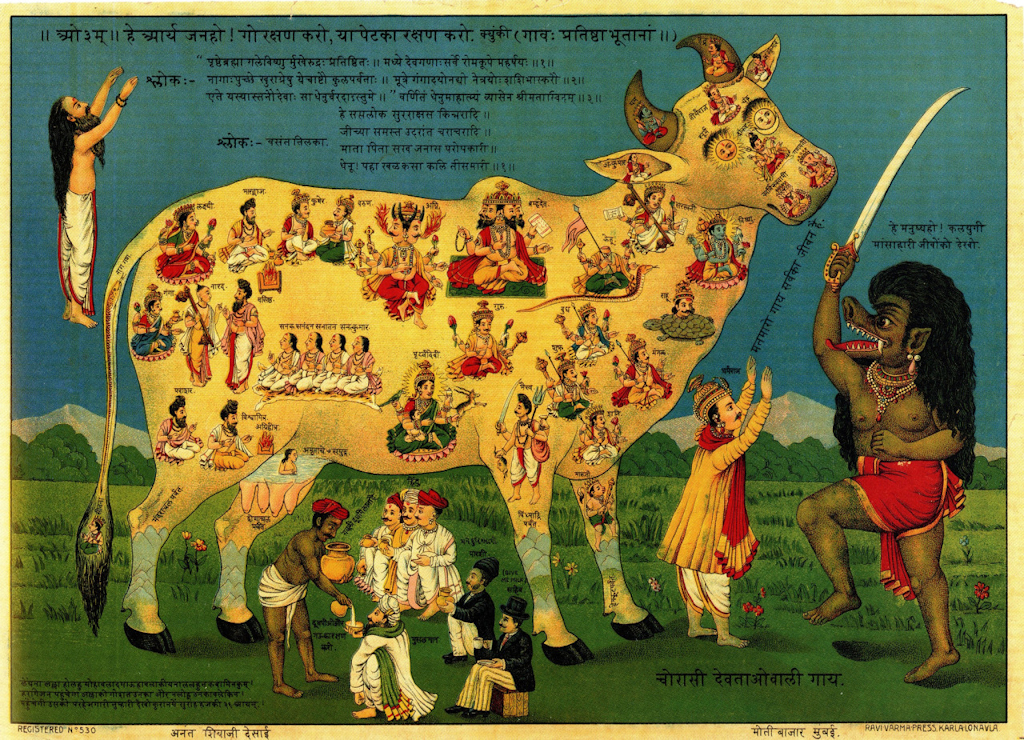
Abb.: Ravi Varma (Malayalam: രവിവമ്മ, 1848 - 1906): "Die Kuh mit den 84
Gottheiten", 1897
[Public domain]
1898 gründet die Britin Annie Besant (1847 – 1933) in Benares das Central Hindū College, Vorläufer des Benares Hindu University.
1902 gibt dieses Hindu College einen Katechismus heraus:
Sanâtana dharma : an elementary text book of Hindu religion and ethics. -- Benares : Central Hindu College, 1902. -- 229 S. -- Online: https://archive.org/details/in.ernet.dli.2015.20734. -- Zugriff am 2018-03-16
Abb.: Titelblatt
Der Katechismus soll Schulkindern die angeblich gemeinsamen Grundlagen des Hinduismus, die allen "Sekten" gemeinsam sind, nahebringen.
Therefore :—
- The religious and ethical instruction must be such as all Hindus can accept.
- It must include the special teachings which mark out Hinduism from other religions.
- It must not include the distinctive views of any special school or sect.
[Aus dem Foreword]
"Deshalb
- muss der Religions- und Ethikunterricht so sein, dass er von allen Hindūs akzeptiert werden kann
- muss er die Eigentümlichkeiten enthalten, die Hinduismus von anderen Religionen abhebt
- darf er nichts enthalten, was spezifisch ist für irgendeine besondere Schule oder Sekte"
1905 hält Annie Besant (1874 - 1933) vor dem Central Hindū College Boarders' Debating Club eine Ansprache über "The Indian Nation". Der Text ist Pflichtlektüre für jeden, der sich mit Hindunationalismus beschäftigt. Ich kann aus Zeitgründen nicht näher darauf eingehen, aber sie finden den Text in der schriftlichen Form dieses Vortrags hier.
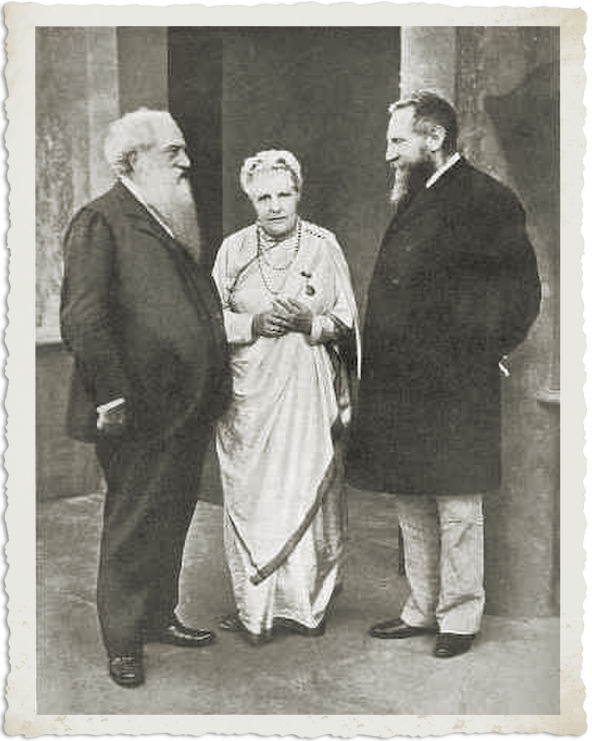
Abb.: Annie Besant (1874 – 1933)
mit Henry Olcott (1832 - 1907) (links) und
Charles Leadbester (1854 - 1934),
Adyar (Tamil
அடையாறு) , 1905
[Public domain]
"The Indian Nation An Address delivered to the Central Hindu College Boarders' Debating Club, 1905.
[...]
We have listened to two thoughtful papers on the bonds which should unite Hindûs. The writer of one speaks of Hindus as part of a nation ; the other considers more the bonds which unite Hindûs as a community within the nation. Let us consider both.
A Common Religion must ever be the strongest bond of union among the Hindûs as a community, and, in order to make Hindûism a strong bond and not a disintegrating force, we must lay stress on what is ancient and universal and ignore what is modern and local. The Sanâtana Dharma Series will aid Hindûism as a unifying force, for it contains all that Hindûs universally accept and leaves out sectarian beliefs. Every boy educated on these lines will be a link of union in the Hindû community, helping to hold it together, and as these teachings spread through the schools and colleges strong bonds of union will be forged.
A Common Language is a bond of union, and Sanskrit and English serve as common languages between Hindûs of north and south, of east and west. The Hindûs of the north and south chant the Mantras in Sanskrit, and discuss business and public questions in English. Therefore Sanskrit should be taught in every English Department, and English in every Pâthshâlâ.
Among the various vernaculars that are spoken in the different parts of India, there is one that stands out strongly from the rest, as that which is most widely known. It is Hindi. A man who knows Hindi can travel over India, and find everywhere Hindi-speaking people. In the north it is the vernacular of a large part of the population, and a large additional part, who do not speak Hindi, speak languages so closely allied to it that Hindi is acquired without difficulty. Urdu is but Persianised Hindi ; Panjâbi and Gurumukhi are dialects of Hindi ; Gujerâti and Marâthi are again dialects of Hindi ; Bengâli is a softer and more melodious and poetical Hindi. It is true that when we travel south we come to language derived from a Dravidian source and not from Sanskrit, and here a real difficulty arises. But the south of India cannot afford to be cut off from the north, and the knowledge of Sanskrit in the south will make easy of acquirement its derivative Hindi, whereas Tamil and Telugu can never become universal in India. The learning of Hindi is a sacrifice that southern India might well make to the unification of the Indian nation. Then Sanskrit will bind Hindûs together in religion, English in imperial and official concerns, and Hindi in social and family life.
A Common Literature is another bond of union, and this all Hindûs have in the Shruti, the Smriti, the Purânas, the Itihâsa, the Philosophies and their commentaries, and the Drama. This vast and splendid literature is the common heritage of all Hindûs, of all sects, of all schools, and it forms one of the strongest bonds of union in the Hindû community.
A common Religion, a common Language, a common Literature, such are the bonds of union among Hindûs as Hindûs.
And now what of Hindûs as part of a people, what of the Indian nation ?
The Indian nation of the future must combine into one coherent and organised body men of various faiths and men of various races, who in the past have been bitter enemies, and have striven against each other for many generations. Hindûs and Mussulmâns, Parsis and Christians, to say nothing of such well-marked inter-Hindû creeds as Jains and Sikhs, have to be welded into a nation, and this not by mergence of all the varying beliefs into one, which is impossible, but by the theosophical recognition of the spiritual unity of all religions, and the broad-minded tolerance and mutual respect which grow out of this recognition. The warring races have to be welded into a nation by turning the memories of strife into memories of common pride.
A common Religion is not possible for India, but a recognition of a common basis for all religions, and the growth of a liberal, tolerant spirit in religious matters, are possible. It is this liberal tolerant spirit which makes nationality possible in Western countries ; Christianity is divided into many more sects than is Hindûism, in addition to the deep lines of cleavage which divide Catholics from Protestants. But these do not interfere with patriotism. In England, France and Germany large numbers of men are unbelievers, but they are none the less good patriots. The bitter religious antagonisms of Italy have not prevented the building of united Italy. Nor need religious differences in India check the building of an Indian nation, if men of all creeds will sink their religious hatreds, and recognise that the God they all worship is the God of humanity, and not a tribal or national deity.
But while a common Religion is impossible, common Languages and a common Literature are possible. For the Muhammadan, Arabic will take the place of Sanskrit, but English is as necessary to him as to the Hindû, and Hindi is his Urdu, stripped of Persian derivatives and written in a different script. In literature he can as heartily enjoy Hindû masterpieces as the Hindû can delight in those born of Islâm. Both belong to the Indian nation, and form its common literature.
Geography has a determining influence on nationality, for true nations cannot co-exist on the same soil. A nation must have its national territory, and we cannot have a Hindu nation, a Mussulmân nation, in India; we must have one Indian nation from the Himâlayas to Cape Comorin, from Bengâl to Kathiawâr. Now such a nation has never yet existed, and “ India ” always has been, and still is, a mere geographical expression. Old India was divided into many States, large and small, and though occasionally, in ancient days, an emperor would be recognised and all the kings became his feudatories, such an emperor ruled by force of his own great personality, and no one Empire endured, and passed from ruler to ruler for generations. Hence India is yet to be made a living reality, an organised entity, and you, the students of to-day with tens of thousands of your like throughout the land, you are to be the builders of India, and from your hands she will emerge—a nation. Let us look around, and take lessons in nation-building, and then you will see that turning Indian communities and races into a nation is by no means an impossible thing.
There are three European nations that may help us—the British, the German, the Italian, and the German most of all. Look at Great Britain. Her people are Kelts, Saxons, Danes, Normans, and their ancestors warred and slaughtered each other for long centuries. Scotland and England were hereditary foes, and a deep river of blood divided them more than the river Tweed. They were united under one Crown just three hundred years ago, after sixteen hundred years of warfare, yet to-day Englishmen are as proud of Bruce and of Wallace as are Scotsmen, and Scotsmen are as proud of Chaucer and Shakespeare as are Englishmen, and both are equally lovers of Britain. Ireland is not yet fused into the nation, for the grass is green over Emmet’s grave for only a century, and race and religion still divide. There the nation still is building, is not yet built.
Italy has swiftly grown into a nation, largely because of the magic of the great name of Rome and her old-world rule ; she has become a nation during the lifetime of many of us, and one of the memories of my childhood is the heroic figure of Garibaldi amid the surging cheering crowds of London folk.
Germany has been made into a nation before our very eyes, and is full of stirring national life and intense patriotic feeling, and Germany is specially instructive for us, because there we see two religions, one in name but bitterly antagonistic in fact, facing each other, the Roman Catholic and the Lutheran, separated by memories of axe and fire, of cruelties more terrible than, and as recent as, the memories of hatred between Hindûs and Mussulmâns here. Yet now both Lutheran and Roman Catholic are brother-citizens of the Empire, and are Germans above all. The German nation is a fact, and it was born before our eyes.
How did Italy, how did Germany, become nations ? By sentiment. That may strike you as strange, and yet not strange if you remember that Thought is the one creative power. There was no Italy. There was no Germany. But poets sang of the Fatherland, authors wrote of the Fatherland, and at last they sang the nation into birth, they sang the Dream into the Fact.How shall the Indian nation be born ? By sentiment also. A feeling is beginning to pervade her races that India is the motherland, and the Indian nation is already a Dream, an Ideal. She exists already in the World of Ideas ; she will pass, she is passing, into the World of Discussion ; and thence she will be born into the World of Facts. This is the Law. This is the Path. First, the Idea, then the Popularisation, then the Fact.
How shall we smooth the path for her coming feet ? We must make the history of India a common history, looking on all her great men as a common glory, on all her heroes as a common heritage. Hindûs must learn to be proud of Akbar, Mussulmâns of Shivaji. The history must lose its bitterness, as of foe against foe, and become the story of the common mother-land in the making, all parties contributing to the enrichment, and sharing in the results. The sense of having been conquered in a battle must pass, and the battle be regarded merely as an event that went to the shaping of the nation. Courage, vigour, strength, virility, these are the sweet fruit of war, grievous and terrible in the sowing ; and these remain alike to conquerors and conquered, when once the sense of personal triumph has faded out of the one, and that of personal loss out of the other. Ours the task so to teach history as to show the use of the struggles to India, as to eradicate proud and injured feelings. Thus shall separateness and hatred pass, and patriotism and love grow up. As boys struggle hard in a match, one side against the other, and afterwards forget the struggle and the bruises received, and use the strength and skill thus obtained in the team which represents the whole college, so must Indians forget the antagonisms of the war-games of the past, and let the wounds be only honourable scars, while they use their strength and skill for the nation.
It may be said : But if this be so, why not educate together the boys of different faiths, why have a Hindû College at Benares, a Muslim College at Aligarh ? Because such separate education is the best for building a religious and moral character, and such characters, once moulded, will live together in peace and mutual respect in manhood. During the plastic years of boyhood it is best to mould and shape the character after its own type, to make the Mussulmân boy a good Mussulmân, the Hindû boy a good Hindi!. When they are firm in their respective religions they can mix together as men, and gain, not lose, by the contact. Only they must be taught a broad and liberal tolerance, as well as an enlightened love for their own religion, so that each may remain Hindû or Mussulmân, but both be Indians. Just as stones are shaped and fitted, and then built into their respective places in an edifice, so must these boys be shaped and fitted by their several religions to be built into the Indian nation.
Let us then hold up as an Ideal the Indian mother-land, the Indian nation ; let us popularise the Idea, till the heart of each province throb in unison ; then let her descend into the world of Facts ; let the Indian nation be born.
[Quelle: Annie_Besant <1847 - 1933>: Essays and adresses. -- Vol. IV: India. -- London : Theosophical Publication Society, 1913. -- S. 236 - 249. -- Online: https://archive.org/details/indiaanniebesant_202004_192_P/page/n249/mode/2up ]
Ab jetzt erscheinen vermehrt Veröffentlichungen, die Ausdruck des Hindū-Selbstbewusstseins sind. Einige wenige Beispiele finden sie hier aufgezählt.
Am 9. Januar 1915 kommt Gāndhī (Gujarati: ગાંધી, 1869 - 1948) aus Südafrika nach Indien zurück. Dieser Nationalist, der voll dem Rollenbild eines indischen Sādhu (Heiligen) entspricht, gibt dem indischen Nationalismus einen unglaublichen Auftrieb. In Gegnerschaft zu Gāndhīs ökumenischem Nationalismus gewinnt der Hindū-Nationalismus (und auch der Muslim-Nationalismus) ebenfalls an Stärke.
Im April 1915 wird die Sarvadeshak Hindū Sabhā gegründet, die sich ab 1921 Akhil Bhāratīya Hindū Mahāsabhā (Hindī अखिल भारतीय हिन्दू महासभा) ("Gesamtindische Hindū-Großversammlung") nennt. Sie wird eine der wichtigsten Organisationen der Vertretung vermeintlicher Rechte der Hindumehrheit im Subkontinent. Hindū heißt für die Mahāsabhā vor allem negativ: kein Angehöriger der "Fremdreligionen" Islam und Christentum, sondern Angehöriger autochthoner - auf dem Subkontinent entstandener Religionen. Diese Abwehr der Fremdreligionen - besonders des Islam - ist typisch für den Nativismus des Hindunationalismus.
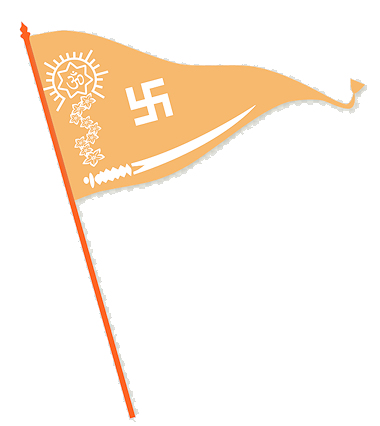
Abb.: ©Flagge
[Fair use]
Da Sanskrit - neben Englisch - die einzige Sprache ist, die auf dem gesamten Subkontinent verbreitet ist, wenn es auch nur von einer kleinen Minderheit von Brahmanen verstanden wird - bedeutet Hindunationalismus auch Sanskritisierung und Brahmanisierung. Dagegen gibt es aber vor allem bei den Tamilen Südindiens einen Gegen-Nativismus: die Tamil-Bewegung, die anti-Sanskrit und anti-brahmanisch ist. So gründet 1916 Maraimalai Adigal (Tamil மறைமலை அடிகள் - Maṟaimalai Aṭikaḷ, 1876 - 1950) das Thani Tamil Iyakkam (Tamil தனித் தமிழ் இயக்கம் - Taṉit tamiḻ iyakkam), die Bewegung für reines und von Sanskrit unabhängiges Tamil. Diese Bewegung ist sehr erfolgreich: Um 1900 hatten ca. 50% der Wörter in Hoch-Tamil ihren Ursprung im Sanskrit, 1950 sind es nur noch 20%. In der Indologie ist viel von Sanskritisierung die Rede, wir sollten die tamilische Entsanskritisierung nicht aus dem Auge verlieren.
Wie sehr der indische Nationalismus um diese Zeit noch fremdbestimmt ist, zeigt die Tatsache, dass im Dezember 1917 die Britin Annie Besant (1847 - 1933) zur Präsidentin der 32. Sitzung des Indian National Congress gewählt wird.
1920 verlässt Muhammad Ali Jinnah, (1876 - 1948) (Urdu محمد علی جناح), der spätere Gründer von Pakistan, den Indian National Congress. Er wird der 1906 gegründeten All-India Muslim League (Urdu آل انڈیا مسلم لیگ) enormen Auftrieb geben, und den Muslim-Nationalismus stärken. Der National Congress wird zwar weiterhin behaupten, auch die Muslime Indiens zu vertreten, dies gilt aber nur in sehr beschränktem Maße.
Im Februar des gleichen Jahres 1923 gründet in Āgrā (Hindī: आगरा): Swāmī Shraddhānand (Hindī: स्वामी श्रद्धानन्द, 1856–1926) die Bhāratīya Hindū Shuddhi Sabhā (Hindī: भारतीया हिन्दू शुद्धि सभा) zur "Rück"konversion von Muslimen zum Hinduismus. Man behauptet, dass man bis Ende 1923 30.000 Malkana (ملکانہ) (muslimische Landadlige) bekehrt und sie wieder als Kshatriyas etabliert hat.
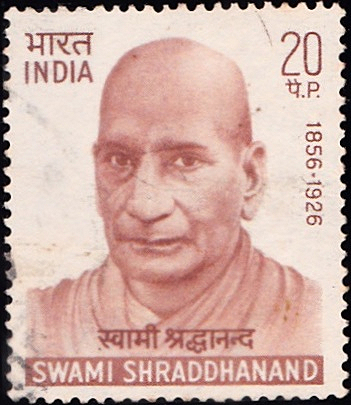
Abb.: Briefmarke, 1970
[Wikimedia / GODL]
1923 erscheint in Nāgpur (Marathi: नागपूर) anonym eines der Grundlagenwerke von Hindutva>
[Savarkar, Vinayak Damodar -- Marathi: विनायक दामोदर सावरकर <1883 - 1966>]: Essentials of Hindutva . -- 1928 erscheint ein Reprint unter dem Titel: Hindutva: Who Is a Hindu?. -- 5.ed online: https://archive.org/stream/hindutva-vinayak-damodar-savarkar-pdf/hindutva-vd-savarkar#page/n1/mode/2up
Verfasser ist Vināyak Dāmodar Sāvarkar (Marathi: विनायक दामोदर सावरकर, 1883 - 1966). Auf Sāvarkar werden sich die folgenden Generationen von Hindutva-Ideologen berufen. Wie es bei der Anrufung von Autoritäten üblich ist, macht man dabei sehr selektiven Gebrauch: Man zitiert, was in den eigenen Kram und die eigene Meinung passt, das andere verschweigt oder verdrängt man. Um nicht demselben Fehler zu verfallen, gebe ich Ihnen in der schriftlichen Form dieser Vorlesung einen repräsentativen Auszug aus diesem Werk. Bitte lesen sie ihn!
Inhalt: "Hindutva is different from Hinduism
- What is in a name?
- Hindutva is different from Hinduism
- What is a Hindu?
- Name older still
- Hindus, a nation
- Other names
- How Names Are Given
- International Life
- Fall of Buddhism
- Buddhism - a universal religion
- Then came reaction !
- Institutions in favour of Nationality
- Commingling of Races
- Back to the Vedas
- Sindhusthan
- What is Arya
- Hindu & Hindusthan.
- Reverence to Buddha
- Hindus : all one and a nation
- Hindusthani Language
- Foreign Invaders
- Hindutva at work
- Stupid notions must go
- Essential implications of Hindutva
- Bond of common blood
- Common culture
- What is civilization ?
- Common laws and rites
- Who is a Hindu ?
- Hindus in Sindh
- Unique Natural Blessings to Hindusthan
To this category of names which have been to mankind a subtle source of life and inspiration belongs the word Hindutva, the essential nature and significance of which we have to investigate into. The ideas and ideals, the systems and societies, the thoughts and´sentiments which have centered round this name are so varied and rich, so powerful and so subtle, so elusive and yet so vived that the term Hindutva defies all attempts at analysis. Forty centuries, if not more, had been at work to mould it as it is. Prophets and poets, lawyers and law-givers, heroes and historians, have thought, lived, fought and died just to have it spelled thus. For indeed, is it not the resultant of countless actions - now conflicting, now commingling, now cooperating - of our whole race? Hindutva is not a word but a history. Not only the spiritual or religious history of our people as at times it is mistaken to be by being confounded with the other cognate term Hinduism, but a history in full. Hinduism is only a derivative, a fraction, a part of Hindutva. Unless it is made clear what is meant by the latter the first remains unintelligible and vague. Failure to distinguish between these two terms has given rise to much misunderstanding and mutual suspicion between some of those sister communities that have inherited this inestimable and common treasure of our Hindu civilization. What is the fundamental difference in the meaning of these two words would be clear as our argument proceeds. Here it is enough to point out that Hindutva is not identical with what is vaguely indicated by the term Hinduism. By an 'ism' it is generally meant a theory or a code more or less based on spiritual or religious dogma or creed. Had not linguistic usage stood in our way then 'Hinduness' would have certainly been a better word than Hinduism as a near parallel to Hindutva. Hindutva embraces all the departments of thought and activity of the whole Being of our Hindu race. Therefore, to understand the significance of this term Hindutva, we must first understand the essential meaning of the word Hindu itself and realize how it came to exercise such imperial sway over the hearts of millions of mankind and won a loving allegiance from the bravest and best of them. But before we can do that, it is imperative to point out that we are by no means attemption a definition or even a description of the more limited, less satisfactory and essentially sectarian term Hinduism. How far we can succeed or are justified in doing that would appear as we proceed.
What is a Hindu?
Although it would be hazardous at the present state of oriental research to state definitely the period when the foremost band of the intrepid Aryans made it their home and lighted their first sacrificial fire on the banks of the Sindhu, the Indus, yet certain it is that long before the ancient Egyptians, and Babylonians had built their magnificent civilization, the holy waters of the Indus were daily witnessing the lucid and curling columns of the scented sacrificial smokes and the valleys resounding with the chants of Vedic hymns - the spiritual fervour that animated their souls. The adventurous valour that propelled their intrepid enterprises, the sublime heights to which their thoughts rose-all these had marked them out as a people destined to lay the foundation of a great and enduring civilization. By the time they had definitely cut themselves aloof from their cognate and neighbouring people especially the Persians, the Aryans, had spread out to the farthest of the seven rivers, Sapta Sindhus, and not only had they developed a sense of nationality but had already succeeded in giving it 'a local habitation and a name! Out of their gratitude to the genial and perennial network of waterways that run through the land like a system of nerve-threads and wove them into a Being, they very naturally took to themselves the name of Sapta Sindhus an epithet that was applied to the whole of Vedic India in the oldest records of the world, the Rigveda itself. Aryans or the cultivators as they essentially were, we can well understand the divine love and homage they bore to these seven rivers presided over by the River, 'the Sindhu'. which to them were but a visible symbol of the common nationality and culture.
The Indians in their forward march had to meet many a river as genial and as fertilizing as these but never could they forget the attachment they felt and the homage they paid to the Sapta Sindhus which had welded them into a nation and furnished the name which enabled their forefathers to voice forth their sense of national and cultural unity. Down to this day a Sindhu - a Hindu - wherever he may happen to be, will gratefully remember and symbolically invoke the presence of these rivers that they may refresh and purify his soul.
Not only had these people been known to themselves as 'Sindhus' but we have definite records to show that they were known to their surrounding nations - at any rate to one of them - by that very name, 'Sapta Sindhu'. The letter 's' in Sanskrit is at times changed into h in some of the Prakrit languages, both Indian and non-Indian. For example, the word Sapta has become Hapta not only in Indian Prakrits but also in the European languages too: we have Hapta i.e., week, in India and 'Heptarchy' in Europe, Kesari in Sanskrit becomes Harhvati in Persian and Asuri becomes Ahur. And then we actually find that the Vedic name of our nation Sapta Sindhu had been mentioned as Hapta Hindu in the Avesta by the ancient Persian people. Thus in the very dawn of history we find ourselves belonging to the nation of the Sindhus or Hindus and this fact was well known to our learned men even in the Puranic period. In expounding the doctrine that many of the Mlechha tongues had been but the mere offshoots of the Sanskrit language the Bhavishya Puran clearly cites this fact and says [...]
Thus knowing for certain that the Persians used to designate the Vedic Aryans as Hindus and knowing also the fact that we generally call a foreign and unknown people by the term by which they are known to those through whom we come to know them, we can safely conclude that most of the remoter nations that flourished then must have applied the same epithet 'Hindu' to our land and people as the ancient Persians did. Not only that but even in the very region of the Sapta Sindhus the thinly scattered native tribes too, must have been knowing the Aryans as Hindus in the local dialects in accordance with the same linguistic law. Further on, as the Vedic Sanskrit began to give birth to the Indian Prakrits which became the spoken tongues of the majority of the descendants of these very Sindhus as well as the assimilated and the crossborn castes, these too might have called themselves as Hindus without any influence for the foreign people. For the Sanskrit S changes into H as often in Indian Prakrits as in the non-Indian ones. Therefore, so far as definite records are concerned, it is indisputably clear that the first and almost the cradle name chosen by the patriarchs of our race to designate our nation and our people, is Sapta Sindhu or Hapta Hindu and that almost all nations of the then known world seemed to have known us by this very epithet, Sindhus or Hindus.
[...]Hindus, a nation
The activities of so intrepid a people as the Sindhus or Hindus could no longer be kept cooped or cabined within the narrow compass of the Panchanad or the Punjab. The vast and fertile plains farther off stood out inviting the efforts of some strong and vigorous race. Tribe after tribe of the Hindus issued forth form the land of their nursery and led by the consciousness of a great mission and their Sacrificial Fire that was the symbol thereof, they soon reclaimed the vast, waste and but very thinly populated lands. Forests were felled, agriculture flourished, cities rose, kingdoms thrived,- the touch of the human hand changed the whole face of the wild and unkemp nature. But while these great deeds were being achieved the Aryans had developed to suit their individualistic tendencies and the demands of their new environments a policy that was but loosely centralised. As time passed on, the distances of their new colonies increased, and different settlements began to lead life politically very much centred in themselves. The new attachments thus formed, though they could not efface the old ones, grew more and more pronounced and powerful until the ancient generalizations and names gave way to the new. Some called themselves Kurus, others Kashis or Videhas or Magadhas while the old generic name of the Sindhus or Hindus was first overshadowed and then almost forgotten. Not that the conception of a national and cultural unity vanished, but it assumed other names and other forms, the politically most important of them being the institution of a Chakarvartin. At last the great mission which the Sindhus had undertaken of founding a nation and a country, found and reached its geographical limit when the valorous Prince of Ayodhya made a triumphant entry in Ceylon and actually brought the whole land from the Himalayas to the Seas under one sovereign sway. The day when the Horse of Victory returned to Ayodhya unchallenged and unchallengeable, the great white Umbrella of Sovereignty was unfurled over that Imperial throne of Ramchandra, the brave, Ramchandra the good, and a loving allegiance to him was sworn, not only by the Princes of Aryan blood but Hanuman, Sugriva, Bibhishana from the south-that day was the realbirth-day of our Hindu people. It was truly our national day: for Aryans and Anaryans knitting themselves into a people were born as a nation. It summed up and politically crowned the efforts of all the generations that preceded it and it handed down a new and common mission, a common banner, a common cause which all the generations after it had consciously or unconsciously fought and died to defend."
"Common cultureBut only two; because a moment's consideration would show that these two qualifications of one nation and one race — of a common fatherland and therefore of a common blood — cannot exhaust all the requisites of Hindutva.
The majority of the Indian Mohammedans may, if free from the prejudices born of ignorance, come to love our land as their fatherland, as the patriotic and noble-minded amongst them have always been doing. The story of their conversions, forcible in millions of cases, is too recent to make them forget, even if they like to do so, that they inherit Hindu blood in their veins. But can we, who here are concerned with investigating into facts as they are and not as they should be, recognize these Mohammedans as Hindus? Many a Mohammedan community in Kashmir and other parts of India as well as the Christians in South India observe our caste rules to such an extent as to marry generally within the pale of their castes alone; yet, it is clear that though their original Hindu blood is thus almost unaffected by an alien adulteration, yet they cannot be called Hindus in the sense in which that term is actually understood, because, we Hindus are bound together not only by the tie of the love we bear to a common fatherland and by the common blood that courses through our veins and keeps our hearts throbbing and our affections warm, but also by the tie of the common homage we pay to our great civilization — our Hindu culture, which could not be better rendered than by the word Sanskriti suggestive as it is of that language, Sanskrit, which has been the chosen means of expression and preservation of that culture, of all that was best and worth-preserving in the history of our race. We are one because we are a nation a race and own a common Sanskriti (civilization)"
[Quelle: Wikipedia: https://en.wikipedia.org/wiki/Hindutva:_Who_Is_a_Hindu?. -- Zugriff am 2018-03-16]
1925 erscheint auf Hindī die Wochen-Zeitschrift Hindū Panch (Hindī: हिन्दू पंच). Ich nenne sie hier, weil ihre Zielsetzung und ihr Motto die Essenz des Hindunationalismus, des Hindutva, präzise ausdrückt:
Ihre Ziele:
Motto auf Titelseite:
लज्जा रखने हिन्दू की, हिन्दू नाम बचाने को।
आया 'हिन्दू पंच' हिन्द में, हिन्दू जाति जगाने को ॥"Die Würde der Hindūs wiederherstellen, Den Namen Hindū bewahren,
Hindū-Herrschaft nach Indien bringen, Hindūs aufwecken."
Das in unserem Zusammenhang wichtigste Ereignis des Jahres 1925 ist die Gründung des
Rāshtrīya Swayamsevak Sangh (RSS) - Hindī: राष्ट्रीय स्वयंसेवक संघ - आर० एस० एस० („Nationale Freiwilligenorganisation“) -- Gegründet 1925-09-27. Er hat heute 5 - 6 Mio. Mitglieder
Abb.: RSS, Bhopal (Hindi भोपाल), 2016
[Bildquelle: Suyash Dwivedi/Wikimedia. – CC-BY-SA 4.0]
Eine der besten Beschreibungen, die ich kenne, ist die, die Indirā Gāndhī (Hindī: इंदिरा प्रियदर्शिनी गांधी, 1917 - 1984), die spätere Ministerpräsidentin, 1947 in einem Brief an ihren Vater, Jawāharlāl Nehrū (Hindī जवाहरलाल नेहरू, 1889 - 1964), gegeben hat.
“Lucknow goes along its own rather dreary way, getting gradually more and more narrow-minded. What a peculiar deadness there is in our provincial towns. And what makes the atmosphere sickening is the corruption and the slackness, the smugness of some and the malice of others. Life here has nothing to offer the not-so-intelligent (and they form the bulk of any class) middle-class young men. It is not surprising that the superficial trappings of fascism attract them in their tens of thousands. The R.S.S. are gaining strength rapidly. They have been holding very impressive rallies in Allahabad, Cawnpore, Lucknow - except for very minor details following the German model almost exactly. I was given a vivid description of the Allahabad show by one of the Malaviya boys. The rally was held in Alfred Park. There were thousands of uniformed volunteers. As each spectator arrived he was given a card for his cycle (as they do for cars in Govt House) or other vehicle. Seating was on the ground but clear white sheets had been spread and each person was allowed just so much room to sit in. People were seated in rows - very orderly. They had to take off their shoes & chappals & here again were given cards so that the shoes should not get mixed up or lost. At the appointed time the announcement was made that proceedings were now starting and that nobody would be allowed to move from his seat or to talk or interrupt in any way. Five minutes were then given so that all who did not wish to stay until the end of the meeting should leave. After that the Guruji & others spoke in pin-drop silence.”
[Quelle: Two alone, two together : Letters between Indira Gandhi and Jawaharlal Nehru 1940 - 1964. -- London : Hodder & Stoughton, 1992. -- S. 547ff. -- Fair use]
Lucknow folgt weiter seinem ziemlich trostlosen Weg, es wird immer engstirniger. Welche Totenstille herrscht in unseren Provinzstädten! Die Atmosphäre ist verpestet durch Korruption und Nachlässigkeit, der Selbstzufriedenheit einiger und der Bosheit anderer. Das Leben hier kann nichts bieten den weniger intelligenten - und diese bilden die Mehrheit jeder Klasse - jungen Männern der Mittelklasse. Es überrascht nicht, dass von den oberflächlichen Fallen des Faschismus zu Zehntausenden angezogen werden. Der RSS gewinnt schnell an Stärke. Sie haben beeindruckende Kundgebungen in Allāhābād, Kānpur, Lucknow abgehalten - sie folgen dabei außer einigen unwichtigen Details fast genau dem deutschen Modell [des Nationalsozialismus]. Ich habe eine lebhafte Beschreibung von der Show in Allāhābād von einem der Mālavīya-Buben bekommen. Die Kundgebung wurde im Alfred Park abgehalten. Es gab Tausende uniformierter Freiwilliger. Jeder Teilnehmer bekam bei der Ankunft eine Nummer für sein Fahrrad oder sonstiges Fahrzeug. Man saß auf dem Boden, aber reinweiße Tücher waren ausgebreitet und jeder durfte nur auf seinem begrenzten Platz sitzen. Man saß in Reihen, sehr ordentlich. Alle mussten ihre Schuhe und Sandalen ausziehen und sie erhielten dafür Nummern, so dass ihre Schuhe nicht verwechselt werden oder verloren gehen konnten. Zum angekündigten Zeitpunkt wurde bekanntgegeben, dass von da an sich niemand von seinem Sitz wegbewegen darf, oder sprechen oder sonstwie unterbrechen darf. Dann gab es fünf Minuten Zeit, dass alle, die nicht bis zum Ende des Treffens verharren wollen, den Platz verlassen. Danach sprachen Gurujī [M. S. Golvalkar] und andere in eine Stille, in der man eine Nadel fallen hören könnte."
Damit ist alles Wichtige gesagt. Vorbilder des RSS sind - wie vom frühen RSS ausdrücklich zugegeben - die faschistische Bewegung (seit 1922) von Benito Mussolini (18883- 1945) und später die nationalsozialistischen Organisationen Adolf Hitlers (1889 - 1945). Im November 1929 übernimmt der RSS das Prinzip
ek chālak anuvartit (Hindī: एक चालक अनुवर्तित) ("Einem einzigen Führer folgen")
Das Titelblatt der Ausgabe im August 2017 der RSS-Wochenzeitschrift पाञ्चजन्य (Pānchajanya) (in Hindī) spricht für sich:
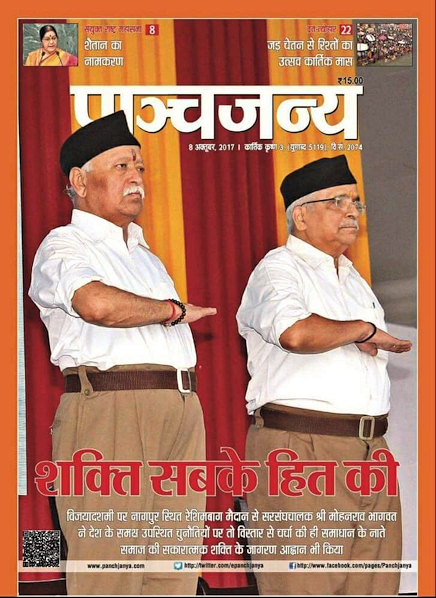
Abb.: Titelblatt der Ausgabe 2017-10-08
[Fair use]
In der Folgezeit versucht sich der RSS als Kaderorganisation in totalitärer Weise institutionell in allen Lebensbereichen einzunisten:
Abb.: RSS und seine Family (Hindi: संघ परिवार)
[Bildquelle: http://www.spandanfeatures.com/increasing-steps-of-rss-in-the-service-of-the-nation/. -- Zugriff am 2018-02-13. -- Fair use]Sangh Parivar - Hindi: संघ परिवार = Dachverband
- Kaderorganisation: Rashtriya Swayamsevak Sangh (RSS) - Hindi: राष्ट्रीय स्वयंसेवक संघ - आर० एस० एस० -- Gegründet 1925-09-27. -- 5 - 6 Mio. Mitglieder
- Politische Organisationen
- The Bharatiya Janata Party (BJP, "Indische Volkspartei") - Hindi: भारतीय जनता पार्टी -- Indian People's Party - politischer Arm des Sangh Parivar (Hindi: संघ परिवार). -- Die Partei ist 1980-12 nach einer Wahlniederlage hervorgegangen aus der Partei Bharatiya Jana Sangh (Hindi: भारतीय जनसंघ), gegründet 1951 übergegangen 1977 in die Janata Party (Hindi: जनता पार्टी). -- Über 100 Mio. Mitglieder
- Bharatiya Janata Yuva Morcha [BJYM] Hindi: भारतीय जनता युवा मोर्चा -- Jugendorganisation der BJP. -- Gegründet 1978
- Berufsorganisationen
- Bharatiya Kisan Sangh - Hindi: भारतीय किसान संघ -- Indian Farmers' Association -- Indiens größte Bauernorganisation. -- Gegründet 1979. -- 20 Mio. Mitglieder
- Bharatiya Mazdoor Sangh - Hindi: भारतीय मजदूर संघ -- Indian Labourers' Association -- Gewerkschaftsorganisation des Sangh. -- Gegründet 1955. -- 11 Mio. Mitglieder (2010)
- Bharatiya Railways Sangh (BRMS) -- Hindi: भारतीय रेल्वे मजदूर संघ -- Indian Railways Workers' Association -- Gegründet: 1962
- Fishermen's Co-operative Societies. -- Gegründet: 1913. -- 2 Mio. Mitglieder
- Samskar Bharati -- Hindi: संस्कार भारती -- Organisation of Indian Artists. -- Gegründet: 1981
- Akhil Bharatiya Adhivakta Parishad -- Hindi: अखिल भारतीय अधिवक्ता परिषद -- All India Lawyers' Council. -- Gegründet: 1992
- Akhil Bharatiya Vidyarthi Parishad (ABVP) - Hindi: अखिल भारतीय विद्यार्थी परिषद - एबीवीपी -- All India Students' Council. -- Gegründet: 1949. -- 3 Mio. Mitglieder
- Akhil Bharatiya Shaikshik Mahasangh -- Hindi: अखिल भारतीय शैक्षिक महासंघ -- All India Teachers' Federation.
- National Medicos Organisation [NMO] -- Organisation von qualifizierten Ärzten und Studierenden der Medizin. -- Gegründet: 1977
- Akhil Bharatiya Poorva Sainik Seva Parishad (ABPSSP) -- Hindi: अखिल भारतीय पूर्व सैनिक सेवा परिषद -- All India Ex-Military Servicemen Council. -- Gegründet: 1995
- Wirtschaftsorganisationen
- Swadeshi Jagaran Manch [oder: Swadeshi Jagran Manch, SJM] - Hindi: स्वदेशी जागरण मंच -- Nativist Awakening Front. -- Wirtschaftsflügel des RSS, die Organisation für ökonomische Unabhängigkeit. -- Gegründet: 1991
- Bhartiya Vitta Salahkar Samiti (BVSS) -- Financial consultants' association. -- Gegründet 1999. -- 900 Mitglieder (2012)
- Laghu Udyog Bharati -- Hindi: लघु उद्योग भारती -- All India organization of Micro and Small Industries in India. -- Gegründet: 1994
- Sahakar Bharati -- Hindi: सहकार भारती -- Cooperative Movement. -- Gegründet: 1978
- Soziale Organisationen
- Deendayal Reseach Institute - Deendayal Shodh Sansthan -- Hindi: दीनदयाल शोध संस्थान. -- Gegründet: 1968
- Bharat Vikas Parishad -- Hindi: भारत विकास परिषद. -- Gegründet: 1963
- Swami Vivekananda Medical Mission. -- Gegründet: 2002
- Sewa Bharati -- Hindi: सेवा भारती -- Community service: Sewa Sanskar Samrasta Samridhi -- Hindi: सेवा संस्कार समृद्धि समरसता (Dienst, Befähigung, Harmonie, Wohlstand). -- Gegründet: 1979
- Sakshama -- Kannada: ಸಕ್ಷಮ
- Hindu Seva Pratishthana -- Kannada: ಹಿಂದು ಸೇವಾ ಪ್ರತಿಷ್ಠಾನ. -- Gegründet: 1980
- Nele -- residential care to destitute children
- Frauenorganisationen
- Rashtra Sevika Samiti - Hindi: राष्ट्र सेविका समिति -- National Volunteer Association for Women. -- Gegründet: 1936
- Shiksha Bharati -- Hindi: शिक्षा भारती -- "To provide education and training for skill up gradation and lifelong learning to girls and women belonging to underprivileged sections of the society."
- Durga Vahini - Hindi: दुर्गा वाहिनी [Armee der Durga]. -- Organisation der Vishva Hindu Parishad für weibliche Jugendliche zwischen 15 und 35 Jahren. -- Gegründet 1984
- Religiöse Organisationen
- Vishwa Hindu Parishad (VHP) [Weltrat der Hindus] - Sanskrit/Hindi: विश्व हिंदू परिषद -- World Hindu Council. -- Gegründet: 1964
- Bajrang Dal - Hindi: बजरंग दल -- militante Organisation der Vishwa Hindu Parishad für junge Männer. -- Gegründet: 1984
- Hindu jagarana vedike -- Kannada: ಹಿಂದು ಜಾಗರಣ ವೇದಿಕೆ
- Dharma Jagran Samanvaya Vibhag - Sanskrit/Hindi: धर्म जागरण समन्वय विभाग / Dharma Jagran Samanvay Samiti - Sanskrit/Hindi: धर्म जागरण समन्वय समिति -- Patriotische Erweckungsbewegung für die Jugend. -- Gegründet: 1996. -- 2000 Hauptamtliche
- Muslim Rashtriya Manch [MRM] -- Hindi: मुस्लिम राष्ट्रीय मंच -- National Front of Muslims -- Organisation des RSS für indische Muslime. -- Gegründet: 2002. -- 10.000 Volunteers (2014)
- Rashtriya Sikh Sangh -- Hindi: राष्ट्रीय सिख संघ / Rashtriya Sikh Sangat -- Hindi: राष्ट्रीय सिख संगत -- Panjabi: ਰਾਸ਼੍ਟ੍ਰੀ ਸਿਖ ਸਂਗਤ -- für die Verbesserung der Beziehungen zwischen Sikhs (Panjabi: ਸਿੱਖੀ) und dem Rest der Hindugesellschaft. -- Gegründet: 1986
- Hindu Munnani -- Tamil: இந்து முன்னணி -- Organisation in Tamil Nadu (தமிழ் நாடு) zur Verteidigung des Hinduismus. -- Gegründet: 1981
- Hindu Rashtra Sena -- Hindi: हिंदू राष्ट्रसेना
- Hindu Aikya Vedi -- Malayalam: ഹിന്ദു ഐക്യവേദി -- Hindu United Front. -- Gegründet: 1992
- Erziehungsorganisationen
- Ekal Vidyalaya -- Hindi: एकल विद्यालय -- "to bring basic education to every child across rural India". -- Gegründet: 1989
- Vidya Bharati Akhil Bharatiya Shiksha Sansthan [Vidya Bharati] -- Hindi: विद्या भारती अखिल भारतीय शिक्षा संस्थान - विद्या भारती. -- für die Erziehung zuständige Organisation (NGO) des RSS. -- Gegründet: 1952/1957
- Saraswati Shishu Mandir -- Hindi: सरस्वती शिशु मंदिर. -- Gegründet: 1952
- Vijnana Bharati [VIBHA] -- Hindi: विज्ञान भारती - विभा. -- zuständig für Wissenschaft und Technologie innerhalb von RSS. -- Gegründet: 1991
- Ethnische Organisationen
- Akhil Bharatiya Vanvasi Kalyan Ashram -- Hindi: अखिल भारतीय वनवासी कल्याण आश्रम. -- Späterer Name: Vanavasi Kalyan Ashram -- Hindi: वनवासी कल्याण आश्रम. -- Organisation für Stammesbevölkerung (Adivasi [Sanskrit/Hindi: आदिवासी] / Vanvasi [Sanskrit/Hindi: वनवासी]). -- Gegründet 1952
- Youth for seva (YFS). -- Gegründet: 2007Friends of Tribals Society -- Vanbandhu Parishad Hindi: वनबंधु परिषद. -- Gegründet: 1989
- Bharat-Tibet Maitri Sangh -- Hindi: भारत तिब्बत मैत्री संघ -- India Tibet Friendship Society (ITFS)
- Propaganda und Kommunikation
- Organiser. -- Wochenzeitschrift. -- Gegründet: 1947
- Vishwa Samvada Kendra (VSK) -- Hindi/Sanskrit: विश्व संवाद केन्द्र -- Official Media Centre of Rashtriya Swayamsevak Sangh, (RSS)
- Hindustan Samachar -- Hindi: हिन्दुस्तान समाचार -- Nachrichtenagentur -- Gegründet: 1948
- Think Tanks
- Bharatiya Vichar Kendra (BVK) -- Sanskrit: भारतीय विचार केंद्रम् -- Kulturinstitut
- Hindu Vivek Kendra -- Hindi: हिन्दू विवेक केन्द्र -- "a resource center for the promotion of Hindutva"Vivekananda Kendra -- Hindi: विवेकानन्द केन्द्र -- Tamil: விவேகானந்த கேந்திரம் -- Entwicklungshilfe bei Stammesbevölkerung
- India Policy Foundation -- Hindi: भारत नीति प्रतिष्ठान
- Bharatiya Shikshan Mandal -- Hindi: भारतीय शिक्षण मंडल -- Organisation zur Unterstützung nationaler Erziehung. -- Gegründet: 1969
- India Foundation
- Akhil Bharatiya Itihas Sankalan Yojana [ABISY] [Akila Bharateeya Itihasa Sankalana Yojana] -- Hindi: अखिल भारतीय इतिहास-संकलन योजना -- All-India history reform project -- Organisation des RSS, deren Aufgabe es ist, die indische Geschichte aus einer nationalen Perspektive zu schreiben. -- Gegründet: 1978
- Syama Prasad Mookerjee Research Foundation (SPMRF)
- Auslandsorganisationen
- Hindu Swayamsevak Sangh -- Hindi: हिन्दू स्वयंसेवक संघ -- Hindu Volunteer Association. -- Gegründet: 1947 in Kenya
- Hindu Swayamsevak Sangh UK [HSS UK] -- Gegründet: 1966
- Hindu Sevika Samiti -- Organisation des HSS UK für Mädchen und Frauen
- Balagokulam -- Organisation des HSS UK für Kinder
- Hindu Sahitya Kendra [Hindu Literature Centre]
- Hindu Swayamsevak Sangh USA [HSS USA]. -- Gegründet: 1989
- Hindu Students Council. -- Gegründet: 1990
- Kinderorganisationen
- Balagokulam (ബാലഗോകുലം / बालगोकुलम) -- "To develop cultural consciousness in children" -- Gegründet: 1981
- Andere Organisationen
- Samskrita Bharati - Sanskrit: संस्कृतभारती -- "Promote the study of Samskrit and make it accessible to all sections of society" -- Gegründet: 1981
- Central Hindu Military Education Society. -- Gegründet: 1937
- Kreeda Bharati (क्रीडा भारती) -- Sports Organization
- Samskar Bharti -- Hindi: संस्कार भारती -- Cultural unit
Damit haben wir die Verbindung zur Gegenwart im unabhängigen Indien nach 1947.
Ich übergehe die Zwischenzeit, aus Zeitgründen -- nicht, weil da nicht sehr Wichtiges und Aufschlussreiches passiert wäre. Sie finden diese Zeit dokumentiert auf Tüpfli: http://www.payer.de/hindutvalink.htm
Eine gute Überleitung zum unabhängigen Indien ist das Gedicht हिन्दुत्व विहीन स्वराज्य से क्या होगा [Hindutva vihīn svarājya kyā hogā - Was soll aus Unabhängigkeit ohne Hindutva werden?], das im Februar 1947 in der Zeitschrift Kalyān der Gītā Press erscheint.
"If we had no Hindutva in us, why would we fight for Swaraj?
We would have become foreigners or Christians then, why would we fight?
Why did we sacrifice so boldly, why did we rot in jail?
Why did we take bullets on our chests, why did we go to the gallows?
What will we get today by sacrificing our religion to please someone?
What will we get from Swaraj without Hindutva?Hindi-Hindu is the religion of Hind, Beautiful is the Hindi language!
Hindi is our food and cloth, Hindi flows in our breath!!
Today Hindi is facing the trap of Hindustani!
Hindus are killed in every manner, while Hind is a witness to the show!!If we wish, today the accomplishment of Pakistan can be drowned!
If we wish, today oppression can be removed from the universe!!
If we wish, today Ram Rajya can be established all over the world!
If only we are able to let dharma dominate over our sins!!"[Übersetzung: Mukul, Akshaya [अक्षय मुकुल]: Gita Press and the making of Hindu India. -- Noida : HarperCollins, 2015. -- 540 S. -- ISBN 978-93-5177-230-9 . -- S. 250f. -- Fair use]
"Wenn wir kein Hindutum in uns haben, warum sollten wir für Autonomie kämpfen?
Wir würden dann Ausländer oder Christen, warum sollten wir kämpfen?
Warum haben wir uns so kühn geopfert, warum sind wir im Gefängnis verrottet?
Warum haben wir Kugeln mit unserer Brust gefangen, warum sind wir zum Galgen gegangen?
Was haben wir von Autonomie ohne Hindutva?Hindī-Hindū ist die Religion von Hind. Wunderschön ist die Hindī-Sprache!
Hindī ist unsere Nahrung und Kleidung, Hindī fließt in unserem Atem!
Heute droht Hindī die Falle des Hindūstānī!
Hindūs werden auf jegliche Art ermordet, während Hind Zeugnis des Schauspiels ist!Wenn wir es wollen, kann die Vollendung Pakistans ertränkt werden!
Wenn wir es wollen, kann Unterdrückung vom Universum genommen werden!
Wenn wir es wollen, kann heute die Herrschaft Rāmas über die ganze Welt errichtet werden!
Wenn wir nur fähig sind, Dharma über unsere Sünden herrschen zu lassen!!"
Das ist Hindū-Nationalismus in Reinkultur. Die Betonung des Hindī tritt später wegen des Widerstands aus Südindien mehr in den Hintergrund.
Hanumān Prasād Poddār (Hindī: हनुमान प्रसाद पोद्दार, 1892–1971) legt im Juli 1947 einen Entwurf für ein unabhängiges Hindū-Indien vor.
"Poddar then presented a twelve-point template for the Hindu-majority independent India, and appealed to 'Congress, Hindu Mahasabha, Sanatanis, Jains, Sikhs to work together to achieve this’.
- India should be called Hindusthan or Aryavarta.
- It should be purely a Hindu nation and entirely organized on the basis of Hindu culture. The national flag should be saffron and Vande Mataram should be the national anthem.
- As a matter of basic principle, cow slaughter should be banned.
- The official language should be pure Hindi (not the corrupt Hindustani) and the script Devanagari.
- Military training should be made compulsory and the Arms Act should be amended.
- The Indian Army should only consist of Hindus. Therefore, the Army should be divided beforehand.
- Muslims should not be appointed to any high post.
- In government jobs Muslims should be appointed based on their percentage in the population. This should be done only if Hindus in Pakistan get government jobs in proportion to their population.
- Laws should not be made for any religion in the name of social reform.
- In the border areas of East and West Bengal, East and West Punjab, North-West Frontier Province and Assam and all other borders, the Central government should deploy a Strong army so that in future India is not attacked.
- Pakistan should be treated as a foreign country and passports be made mandatory for travelling there.
- In India, Muslims and other minorities should be given adequate facilities. Their life and dignity should be protected.
In addition, Poddar spelt out eight principles that every Hindu should follow:
- Honour India’s ancient culture, its glorious history as well as show respect and imbibe the valour and knowledge of great men of the past.
- Take pride in Hindutva. A Hindu of any varna, jati or faith should know that his primary identity is of a Hindu. Such unity would result in helping each other.
- Despite social differences, make united efforts to create a great Hindu rashtra.
- Substitute selfish traits like personal ambition, hankering for power and craving for honour and wealth by service to the nation.
- Help the weak and poor with dedication, money and might. Never be afraid of oppressors (in the present context this could mean Muslims). They should be exterminated with all possible means. Not doing anything (in retaliation) to their oppression would be a sin just the way it is to oppress the poor.
- Consider yourself invincible and strong and always work in that direction.
- Have belief in God’s unlimited power and benevolence, and conserve energy to fight internal and external enemies.
- Consider every work as worship of God."
[Quelle: Mukul, Akshaya [अक्षय मुकुल]: Gita Press and the making of Hindu India. -- Noida : HarperCollins, 2015. -- 540 S. -- ISBN 978-93-5177-230-9 . -- S. 254f. -- Fair use]
Die ersten vier Forderungen:
Ab 3. Juli 1947 erscheint bis heute das englischsprachige Zentralorgan des RSS -- "Organiser"

Abb.: ©Balken
[Fair use]
Webpräsenz:
- http://www.organiser.org/. -- Zugriff am 2018-02-22
- https://www.facebook.com/eOrganiser/. -- Zugriff am 2018-02-24
Dann wurde Indien um Mitternacht vom 14. zum 15. August 1947 unabhängig. Der Subkontinent wurde geteilt. Die Folgen der übereilten Teilung sind katastrophal. Doch dies ist nicht Gegenstand dieser Vorlesung.
Schon am 7. Dezember 1947 schreibt Ministerpräsident Jawāharlāl Nehrū (Hindī: जवाहरलाल नेहरू, 1889 - 1964) an die Chefs der Provinzialregierungen über den RSS :
"We have a great deal of evidence to show that the RSS is an organisation which is in the nature of a private army and which is definitely proceeding on the strictest Nazi lines, even following the technique of organisation. [...] I have some knowledge of the way the Nazi movement developed in Germany. It attracted by its superficial trappings and strict discipline considerable numbers of lower middle class young men and women who are normally not too intelligent and for whom life appears to offer little to attract them." [Zitiert in: Jaffrelot, Christophe <1964 - >: The Hindu nationalist movement in India. -- New York : Columbia Univ. Pr., 1996. -- 592 S. : Ill. -- Originaltitel: Les nationalistes hindous (1993). -- S. 87. -- Fair use]
"Wir haben gewichtige Hinweise, dass der RSS eine Organisation ist, deren Natur eine Privatarmee ist, und die genauest auf der Linie der Nazis steht, bis hinein in die Technik der Organisation. [...] Ich weiß in etwa, wie sich die Nazibewegung in Deutschland entwickelte. Durch ihre oberflächlichen Fallen und strenge Disziplin zog sie beachtliche Mengen von jungen Männern und Frauen des unteren Mittelstandes an; Leute, die normalerweise nicht übermäßig intelligent sind, und denen das Leben wenig Anziehendes bietet."
Sie hören den früher zitierten Brief von Indirā Gāndhī (Hindī: इंदिरा प्रियदर्शिनी गांधी, 1917 - 1984) an ihren Vater heraus.
Am 30.1.1948 trägt der fanatische Hindunationalismus seine bekannteste Frucht: Nathūrām Vināyak Godse (Marathi: नथूराम गोडसे, 1910 – 1949) ermordet Mohandās Karamchand Gāndhī (Gujarati: મોહનદાસ કરમચંદ ગાંધી, 1869 - 1948). Nathūrām Godse kommt aus dem RSS In der Folge wird der RSS bis 1949 verboten. 80.000 RSS-ler werden verhaftet.

Abb.: Büste von Nathuram Vinayak Godse (Marathi: नथूराम गोडसे, 1910
– 1949) im Gwalior (Hindi: ग्वालियर)
Office der Hindu
Mahasabha (Hindi: हिन्दू महासभा),
2017
[Bildquelle: ©https://www.indiatoday.in/india/story/nathuram-godse-mahatma-gandhi-mahatma-gandhi-mahasabha-1091075-2017-11-21.
-- Fair use]
In der Nacht vom 22. zum 23. Dezember 1949 stellen Angehörige der Hindū Mahāsabhā (Hindī: हिन्दू महासभा) in der Babri Moschee (Urdu: بابری مسجد) in Ayodhya (Hindī: अयोध्या) ein Bildnis vom Kind Rāma (Rāmlallā -- Hindī: रामलल्ला) und die Bildnisse von Rāma und seiner Gattin Sītā auf. Der Ort der Moschee gilt als Geburtsort Rāmas. Damit beginnt die blutige Tragödie des Kampfes um den Bau eines Rāma-Geburtstempels auf dem Platz der Moschee.
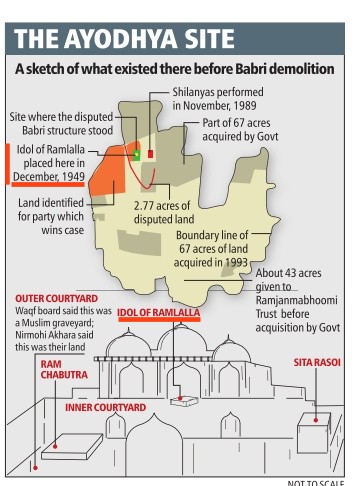
Abb.: Lage des Ramlalla-Bildnisses (Hindi: रामलल्ला)
[Bildquelle:
http://workshop.mod.org.in/?p=1443. -- Zugriff am 2018-03-28. --
CC BY-NC-SA 2.5
IN]
Am 17. Dezember 1950 wird der Hindunationalismus durch die Geburt seines künftigen politischen Führers beschenkt: in Vadnagar (Gujarati: વડનગર) in Gujarāt wird Narendra Dāmodardās Modī (Gujarati: નરેંદ્ર દામોદરદાસ મોદી) geboren. Er gehört der Ghānchī-Kaste (Gujarati: ઘાંચી) (Ölmüller) an, die zu den OBC (Other Backward Classes) gezählt wird. Sein Vater ist Inhaber einer Teebude auf dem Bahnsteig des örtlichen Bahnhofs.
1959 tritt Modī dem RSS bei.
1969 überzeugt ein Swāmi Narendra Modī, dass dieser ungeeignet ist, ein Rāmakrishna Mönch zu werden. Dies ist der Beginn der politischen Karriere Modīs.
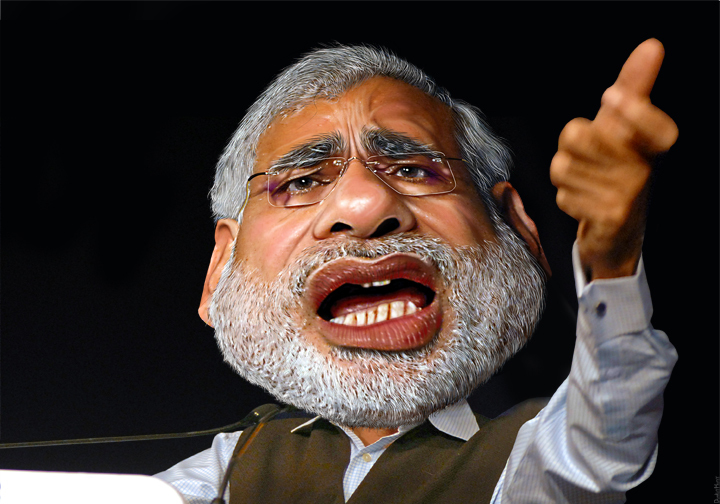
Abb.: Narendra Damodardas Modi (Gujarati: નરેંદ્ર દામોદરદાસ મોદી)
[Bildquelle: DonkeyHotey. --
https://www.flickr.com/photos/donkeyhotey/14036449217/in/photolist-nomtk8-SoFuNG-qCq93b-22GyhKC-idwndN-cTkbSu-9DWE23-aFW3wZ-m9tbYe-vVL7rY-9eRpAR-beo68Z-axnnhd-gqWpDe-VV1asP-qTT42C-osjcrx-U9Sz7G-RDdLSb-T3TuLu-9CG51N-qr87BR-awNySm-TcQKtE-T3Tuzh-pF8YZp-VYEG4n-sm1N64-9HwxiN-9DTDXi-c6hLB7-9sdtzW-amWmM9-bdhJyF-QDKpjh-Xm33oZ-amTCWH-sa7zBB-dHPrCR-9HtFA2-9CG6KA-gx8YaG-bq9k1H-gUMZwB-9rknN8-aedou5-X8yguY-9uayT3-9qN2k9-kwGXNM.
-- Zugriff am 2018-03-25. --
CC BY-SA 2.0]
Modī erklärt später in seinem Leben seine Einstellung zu Hindutva (nicht datiert):
"I believe that Hindutva is a way of life. It has survived all kinds of assaults. In the past ten thousand years, so many vicharadharas (ideologies) have suffered in some way or the other. Not Hinduism. Hinduism stays with the times. It keeps up with the times. It is relevant to our times. Hindutva teaches restraint, advises individuals not to be a burden on society, and suggests responsibility. Hindutva is over ten thousand years old; Christianity some two thousand years old, and Islam about 1,400 years old. Christianity and Islam are religions. Hindutva is a way of life. It is incomparable and scientific. In ancient Sanskrit it is known as sanatana dharma or the eternal way of life. It is not rigid. It is liberal, able to adjust." [Zitiert in: Kamath, M. V. [ಎಮ್. ವಿ. ಕಾಮತ್] <1921 - 2014> ; Randeri, Kalindi: The man of the moment : Narendra Modi. -- New Delhi : Times, 2013. -- 419 S. : Ill. -- ISBN 978-93-259-6838-7. -- S. 178. -- Fair use]
"Ich glaube, dass Hindutva eine Lebensform ist. Es hat alle Angriffe überlebt. In den letzten 10.000 Jahren haben so viele Ideologien auf die eine oder andere Weise Schaden erlitten. Nicht der Hinduismus. Hinduismus überdauert die Zeiten. Er hält Schritt mit den Zeiten. Er ist relevant für unsere Zeiten. Hindutva lehrt Selbstbeschränkung; lehrt die Individuen, der Gesellschaft nicht zur Last zu fallen, legt Verantwortlichkeit nahe. Hindutva ist über 10.000 Jahre alt, Christentum ist etwas über 2.000 Jahre alt, Islam ist ungefähr 1.400 Jahre alt. Christentum und Islam sind Religionen. Hindutva ist eine Lebensform. Es ist unvergleichbar und wissenschaftlich. Im alten Sanskrit ist es bekannt als sanatana dharma oder die ewige Lebensform. Es ist nicht starr. Es ist liberal, anpassungsfähig."
Nach einer Quelle gibt es 1951 631.500 Swayamsevak (Freiwillige) (Hindī: स्वयंसेवक) des RSS. Davon ca. 300.000, die voll teilnehmen. Die regionale Verteilung zeigt folgende Karte:
Abb.: Regionale Verteilung der 631.500 Swayamsevak (Hindi: स्वयंसेवक) des RSS, 1951
[Datenquelle: Curran, J. A. (Jean Alonzo <Jr.>): Militant Hinduism in Indian politics : a study of the R.S.S. -- New York : International Secretariat, Institute of Pacific Relations, 1951. -- 94 S. -- S. 44. -- Online: https://babel.hathitrust.org/cgi/pt?id=mdp.39015031477741;view=1up;seq=7 . -- Zugriff am 2018-05-29]
[Kartenquelle: Furfur/Wikimedia. -- CC BY-SA 4.0]
Die Auseinandersetzung um den Hindunationalismus verläuft keineswegs nur auf friedlicher ideologischer oder demokratisch-politischer Ebene. Sie hinterlässt eine Spur der Gewalt und des Mordens in sogenannt kommunalen Randalen (communal riots). Die beiden folgenden Statistiken geben einen Eindruck des Blutvergießens:
Anzahl der kummunalen Randalen (communal riots) und der dabei Getöteten 1950 - 2002
Abb.: Anzahl der communal riots und der dabei Getöteten 1950 - 2002
[Datenquelle: Engineer, Ashgar Ali <1939 - 2013> [ اصغر علی انجینئر] : Communal riots after independence : a comprehensive account. -- Mumbai : Centre for Study of Society and Secularism, 2004. -- 253 S. : Ill. -- ISBN 81-7541-150-3. -- S. 223f. -- Fair use]
Tote bei communal riots in einzelnen Staaten
Abb.: Tote bei communal riots in einzelnen Staaten, 1960 -2002
[Datenquelle: Engineer, Ashgar Ali <1939 - 2013> [ اصغر علی انجینئر] : Communal riots after independence : a comprehensive account. -- Mumbai : Centre for Study of Society and Secularism, 2004. -- 253 S. : Ill. -- ISBN 81-7541-150-3. -- S. 229. -- Fair use]
[Bildquelle: Maximilian Dörrbecker (Chumwa)/Wikimedia. -- CC BY-SA 2.5]
Ich habe die Vorlesung mit einem Zitat eines Dalit, eines Unberührbaren, begonnen. Dr. B. R. Āmbedkar (Hindī: भीमराव रामजी आंबेडकर, 1891 - 1956), der wichtigste Anführer der Dalit, ist in Auseinandersetzung mit Gāndhī zur Überzeugung gekommen, dass für Dalits im Hinduismus kein Platz ist. Deshalb nimmt er am 14. Oktober 1956 in Nāgpūr (Marathi: नागपूर) formell die Dreifache Zuflucht und konvertiert damit öffentlich zum Buddhismus. Anschließend konvertiert ca. eine halbe Million Unberührbare (Dalits) zum Buddhismus.
Erstmalig in der Geschichte des Buddhismus, schwören die Konvertiten dem Hinduismus ab:
“1. I shall have no faith in Brahma, Vishnu and Mahesh, nor shall I worship them.
2. I shall have no faith in Rama and Krishna, nor shall I worship them.
3. I shall have no faith in ‘ Gouri ’, ‘ Ganpathi ’, and other Gods and Goddesses of Hindu religion, nor shall I worship them.
4. I do not believe in the theory of incarnation of Gods.
5. I do not and shall not believe that the Lord Buddha was the incarnation of Vishnu. I believe this to be, mischievous and false propaganda.
...
19. I hereby embrace Buddhism by renouncing my old Hindu religion which is detrimental to the prosperity to the humankind and discriminate human beings and treat them low.
- "Ich werde nicht an Brahma, Vishnu und Mahesh glauben; noch werde ich sie verehren.
- Ich werde nicht an Rāma und Krishna glauben; noch werde ich sie verehren.
- Ich werde nicht an Gauri, Ganapathi und andere Götter und Göttinnen der Hindū-Religion glauben; noch werde ich sie verehren.
- Ich glaube nicht und werde nicht glauben an die Theorie der Inkarnationen der Götter.
- Ich glaube nicht und werde nicht glauben, dass Buddha eine Inkarnation Vishnus war. Ich glaube, dass dies bösartige und falsche Propaganda ist.
usw.
- Ich nehme damit den Buddhismus an, indem ich meine alte Hindū-Religion aufgebe, die schädlich ist für das Wohlergehen der Menschheit, Menschenwesen diskriminiert und erniedrigt."
Āmbedkar stirbt kurz danach und wird heutzutage von Hindunationalisten als vergöttlichter Heiliger propagandiert, indem man seine Feindschaft zum Hindutum verschweigt. Man braucht ihn, um die Dalits zu gewinnen und ihnen die Bezeichnung Hindū aufzuzwingen, selbst wenn sie zum Buddhismus konvertiert sind.
Abb.: Ambedkar-Titel der RSS-Zeitschrift Organiser
[Fair use]
Der 25. Juni 1975 ist ein Glücksfall für die Hindunationalisten: Auf Antrag von Ministerpräsidentin Indirā Gāndhī (Hindī: इंदिरा प्रियदर्शिनी गांधी, 1917 - 1984) erklärt der Staatspräsident den internen Ausnahmezustand. Dieser dauert bis März 1977. Tausende von Oppositionellen sowie Gegner der Gāndhī-Familie werden verhaftet (diese Gandhis sind mit Mahātmā Gāndhī NICHT verwandt). Der RSS wird verboten, einige Tausend seiner Mitglieder werden verhaftet. Die meisten - unter ihnen vor allem auch Narendra Modī - arbeiten im Untergrund weiter. Es bildet sich eine Front unterschiedlichster Ideologien gegen Indirā Gāndhī. Der RSS bekommt die Märtyrerkrone, die er im Unabhängigkeitskampf nicht erworben hatte. Bis heute zehrt der Hindunationalismus von dieser Märtyrerrolle im Kampf gegen die Diktatur des Ausnahmezustands.
Im Jahr 1980 wird die hindunationalistische Bhāratīya Janatā Party (Hindī भारतीय जनता पार्टी, "Indische Volkspartei") gegründet. Ihre fünf Verpflichtungen definiert sie in bewusst schwammiger Weise:
Die fünf commitments:
- “nationalism and national integration”
- “democracy”
- “positive secularism”
- “Gandhian socialism”
- “value-based politics”.
[Quelle: Our five commitments / Bharatiya Janata Party. -- Delhi: Asiatic Printers, 1981. -- 20 S.]
- "Nationalismus und nationale Integration
- Demokratie
- positiver Säkularismus [im Gegensatz zum Säkularismus Nehrus]
- Gandhischer Sozialismus
- Werte-basierte Politik"
Die BJP ruht zwar auf dem Fundament von Hindutva und RSS, vertritt aber keineswegs offen lupenreines Hindutva. Als politische Partei ist sie bemüht, möglichst viele Wähler zu gewinnen, also verschiedenste Arten von Klientel anzusprechen. Daraus folgt, dass BJP ideologisch schillernd ist.
Um die nationale Integration zu fördern, werden in der Folgezeit verschiedene Yātrās (Rallies) durchgeführt. z.B. im November 1983 die Ekātmā Yātrā.
Ekatmata Yatra (Sanskrit: एकात्मता यात्रा) der Vishwa Hindu Parishad (Sanskrit: विश्व हिंदू परिषद्)
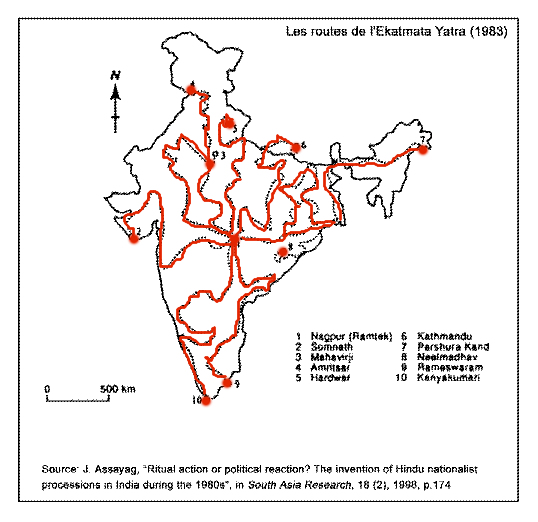
Abb.: Routen der Ekatmata Yatra (Sanskrit: एकात्मता यात्रा)
[Bildquelle: Jaffrelot, Christophe <1964 - >:
https://www.cairn.info/revue-politix-2007-1-page-79.html#pa24. -- Zugriff am
2018-03-26. -- Fair use]
Die Yātrā (यात्रा)
besteht aus 312 Einzelyātrās
hat 4.323 Treffpunkte
berührt 531 der 534 Distrikte Indiens
vermarktet 6.000 Bilder von Bhārat Mātā (Hindī: भारत माता - Mutter Indien) zu je ½Rupie
vermarktet 70.000 Halbliterflaschen mit Gangeswasser á 10 Rupies
beschäftigt 50.000 Swayamsevak (Freiwillige) (स्वयंसेवक) des RSS
kostet 6 Mio. Rupies, bringt aber bedeutend mehr Einnahmen
Dies ist Kult an der Nationalgöttin Bhārat Mātā - Mutter Indien.
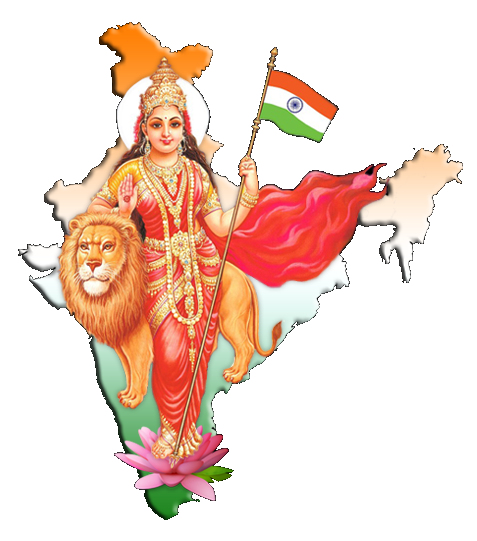
Abb.: Bharat Mata (Hindi: भारत माता - Mutter Indien)
[Bildquelle: Akhand hind fauj/Wikimedia. --
CC BY-SA 4.0]
Ganz wichtig für die Erweckung des Hindunationalbewusstseins in weiten Bevölkerungskreisen sind die 78 Folgen der Fernsehserie Rāmāyan, die der staatliche Fernsehsender Doordarshan von Januar 1987 bis Juli 1988 sendet. Die Serie ist ein echter Straßenfeger.
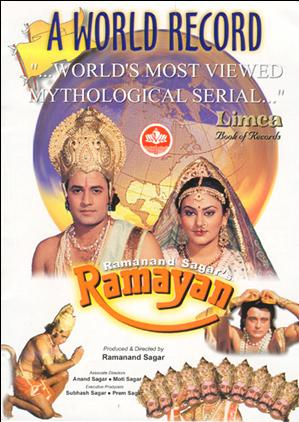
Abb.: Poster
[Fair use]
Nicht zu unterschätzen bei der Verbreitung der Hindutva Ideologie - vor allem des Kampfes für einen Tempel am angeblichen Geburtsort Rāmas - ist der Einfluss von Audiokassetten, die billig landesweit verbreitet wurden.
Als Beispiel möge ein auf diese Weise verbreitetes Hindī-Gedicht genügen:
May our race not be blamed
And may our mothers not say
That when we were needed, we weren’t ready
If there must be a bloodbath
Then let’s get it over with
Because of our fear of a bloodbath before
Our country was divided [at partition]
Since their arrival until today
They have killed so many Hindus
We tried to appease them
But there was bloodshed after all
Instead of having it simmer slowly
It’s better to have it burst with a big flame
If they don’t understand our words
Then we’ll make them understand with kicks
If there must be a bloodbath, then let it happen.[Übersetzung: Peter Manuel. -- In: Making India Hindu : religion, community, and the politics of democracy in India / ed. by David Ludden, .. Delhi : Oxford UP, 1996. -- 346 S. -- ISBN 0-19-564380-1. -- S. 131ff. -- Fair use]
"Möge unsere Rasse nicht beschuldigt werden
Und mögen unsere Mütter nicht sagen,
Dass wir nicht bereit waren, als wir benötigt wurden.
Wenn ein Blutbad sein muss,
Dann lass es uns hinter uns bringen.
Denn aus Angst vor einem Blutbad
Wurde unser Land geteilt.
Seit ihrer [der Muslime] Ankunft bis heute
Haben sie so viele Hindūs getötet.
Wir haben versucht, sie zu besänftigen,
Aber es gab trotz allem Blutvergießen.
Statt auf Sparflamme zu kochen,
Ist es besser, es mit großer Flamme explodieren zu lassen.
Wenn sie unsere Worte nicht verstehen,
Dann werden wir sie mit Tritten verstehen machen.
Wenn ein Blutbad sein muss, dann lasst es geschehen."
Während des ganzen Sommers 1989 organisiert die Vishwa Hindū Parishad (Sanskrit: विश्व हिंदू परिषद्) mit Hilfe des RSS Rām Shilā Pūjan Feiern (Hindī: राम शिला पूजन). Dabei werden Ziegel (Hindī: शिला - shilā), in die der Name Rāmas [राम] gepresst oder aufgemalt ist, verehrt. Die Ziegel sind gedacht für den Bau eines Rāma Geburtstempels an der Stelle der Babri-Moschee (Urdu: بابری مسجد) in Ayodhyā (Hindī: अयोध्या).
Bei den Pūjans (Hindī: पूजन) werden vorgefertigte Kassetten abgespielt mit Songs und Ansprachen. Aus einer solchen Kassette:
"The blood of foreigners, of traitors who do not pay tribute to the ancestors, will flow. [...] Ram Shilas [Hindi: राम शिला] will be the protectors of the Hindu culture. [...] The foreign conspiracy will not succeed any more. The Ram Shilas will mean death for those who call mother India a witch." [Zitiert in: Jaffrelot, Christophe <1964 - >: The Hindu nationalist movement in India. -- New York : Columbia Univ. Pr., 1996. -- 592 S. : Ill. -- Originaltitel: Les nationalistes hindous (1993). -- S. 396. -- Fair use]
"Das Blut von Ausländern wird fließen, das Blut von Verrätern, welche die Ahnen nicht würdigen. ... Rāma-Ziegel werden die Beschützer der Hindū-Kultur sein. ... Die ausländische Verschwörung wird keinen Erfolg mehr haben. Die Rāma-Ziegel werden Tod bedeuten für die, welche Mutter Indien eine Hexe nennen."
Bei Demonstrationen werden Slogans geschrien wie
"Es gibt nur zwei Orte für Muslime: Pakistan oder der Friedhof."
Hindunationalismus ist nicht die Sache einiger weniger Spinner.
Laut einer Umfrage glauben 1993, dass Hindunationalismus eine positive Wirkung auf das Leben in Indien hat
Nicht unbedeutend für das Selbstbewusstsein von Hindunationalisten ist die Unterstützung aus dem Ausland:Als Beispiel dafür sei genannt die 2001 erschienene zweibändige Verteidigungsschrift für RSS und BJP von
Elst, Koenraad <1959 - >: The saffron swastika : the notion of "Hindu fascism". -- New Delhi : Voice of India, 2001. -- 2 Bde. ; 1070 S. -- ISBN: 8185990697
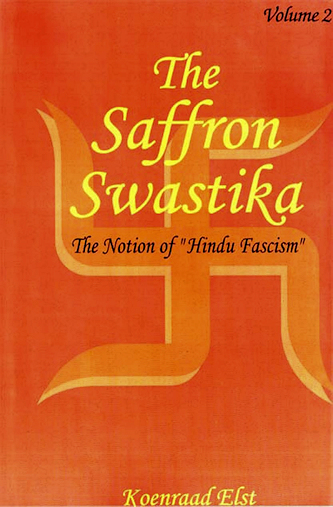
Abb.: Einbandtitel
[Fair use]
Vor dem Februar 2002 werden in den Städten Gujarāts (Gujarati: ગુજરાત) von der Vishwa Hindū Parishad (Sanskrit: विश्व हिंदू परिषद्) Flugblätter wie dieses verteilt:
"Vishwa Hindu Parishad Satyam Shivam Sundaram!
Jai Shri Ram!
Wake up! Arise! Think! Enforce! Save the country! Save the religion!
Economic boycott is the only solution! The anti-national elements use the money earned from the Hindus to destroy us! They buy arms! They molest our sisters and daughters! The way to break the backbone of these elements is:
An economic non-cooperation movement!
Let us resolve
1. From now on I will not buy anything from a Muslim shopkeeper!
2. I will not sell anything from my shop to such elements!
3. Neither shall I use the hotels of these anti-nationals nor their garages!
4. I shall give my vehicles only to Hindu garages! From a needle to gold, I shall not buy anything made by Muslims, neither shall we sell them things made by us!
5. I shall boycott wholeheartedly films in which Muslim heroes and heroines act! Throw out films produced by these anti-nationals!
6. We will never work in offices of Muslims! We'll not hire them!
7. We'll not let them buy offices in our business premises nor sell or rent out houses to them in our housing societies and colonies.
8.. I shall certainly vote, but only for him who will protect the Hindu nation.
9. I shall ensure that our sisters and daughters do not fall into the 'love-trap' of Muslim boys at schools, colleges and workplaces.
10. I shall not receive any education or training from a Muslim teacher.
Such a strict economic boycott will throttle these elements! It will break their back-bone! Then it will be difficult for them to live in any corner of this country. Friends, begin this economic boycott from today! Then no Muslim will raise his head before us! Did you read this leaflet? Then make ten photocopies of it and distribute it to our brothers. The curse of Hanumanji be on him who does not implement this and distribute it to others! The curse of Ramchandraji will also be on him! Jai Shri Ram!
A true Hindu patriot.
N.B. The kites we use on kite-flying day are also made by Muslims. The fireworks are also made by them. We should boycott these too. Jai Shri Ram!"
[Quelle der Übersetzung: MITRA, ASHOK: SHALL NOBODY SAVE US?. -- https://www.telegraphindia.com/1020328/editoria.htm#head3. -- Zugriff am 2018-04-19. -- Fair use]"Vishwa Hindū Parishad
Satyam Shivam Sundaram
Jai Shrī Rām! ["Heil Rāma!]Wacht auf! Steht auf! Vollstreckt! Rettet das Land! Rettet die Religion!
Wirtschaftsboykott ist die einzige Lösung! Die anti-nationalen Elemente [d.h. die Muslime] nutzen das Geld, das sie an den Hindūs verdienen, um uns zu zerstören! Sie kaufen Waffen! Sie belästigen unsere Schwestern und Töchter! Der Weg, um diesen Elementen das Rückgrat zu brechen ist:
Eine Bewegung der wirtschaftlichen Nicht-Zusammenarbeit! [Sie hören Gāndhīs non-cooperation]
Lasst uns beschließen:
- Ab jetzt werde ich nichts mehr bei einem muslimischen Händler kaufen!
- Ich werde in meinem Geschäft nichts an solche Elemente verkaufen!
- Ich werde weder die Hotels noch die Garagen dieser Anti-Nationalen nutzen!
- Ich gebe meine Fahrzeuge nur Hindū-Garagen! Von einer Nadel bis zu Gold - ich werde nichts von Muslimen Produziertes kaufen; auch werde ich ihnen nicht verkaufen, was wir verfertigt haben.
- Aus ganzem Herzen werde ich Filme boykottieren, in denen Muslime Schauspieler oder Schauspielerinnen sind! Werft Filme hinaus, die von diesen Anti-Nationalen produziert wurden!
- Wir werden nie in Büros von Muslimen arbeiten! Wir werde sie nicht anstellen!
- Wir werden sie keine Büros in unseren Bürogebäuden kaufen lassen; wir werden ihnen auch keine Häuser in unseren Wohngesellschaften oder Wohnkolonien verkaufen oder vermieten.
- Ich werde gewiss wählen, aber nur jemanden, der die Hindū-Nation beschützen will.
- Ich werde sicherstellen, dass unsere Schwestern und Töchter in Schulen, Colleges und Arbeitsplätzen nicht in die 'Liebes-Falle' von Muslim-Jungen fallen.
- Ich werde keine Bildung oder Unterrichtung von einem Muslim-Lehrer annehmen.
Ein solcher strenger wirtschaftlicher Boykott wird diese Elemente erdrosseln! Er wird ihr Rückgrat brechen! Dann wird es für sie schwer sein, in irgend einem Winkel dieses Landes zu leben. Freunde, beginnt heute noch diesen wirtschaftlichen Boykott! Dann wird kein Muslim sein Haupt vor uns erheben! Hast Du diese Flugblatt gelesen? Dann mache zehn Photokopien davon und verteile sie an unsere Brüder. Der Fluch Hanumāns sei über dem, der das nicht erfüllt und das Flugblatt an andere verteilt! Der Fluch Rāmachandras wird ebenso auf ihm sein! Heil Rāma!
Ein wahrer Hindū Patriot
N.B. Die Drachen, die wir am Drachenflugtag verwenden, sind von Muslimen gemacht. Auch die Feuerwerkskörper sind von ihnen gemacht. Wir sollten auch diese boykottieren. Heil Rāma!"
Solche Atmosphäre der Hetze führt konsequent zum Ausbruch von Gewalt. Vom 27. Februar 2002 bis in den März hinein wird Gujarāt von Gewalttaten erschüttert. Der Chief Minister und heutige Chief Minister Narendra Modī schweigt und schaut zu.
Am Anfang steht das Eisenbahnattentat von Godhrā (Gujarati ગોધરા) am 27. Februar 2002: ca. 2000 Hindū Pilger kehren mit dem Sābarmatī-Express von Ayodhyā Richtung Ahmedābād zurück. In Ayodhyā hatten sie an einem Fest der Vishwa Hindū Parishad am angeblichen Geburtsort Rāmas teilgenommen. In Godhrā wird der Zug von einer großen Meute wütender Muslime erwartet. Eine Gruppe von ihnen verübt einen Brandanschlag auf den Zug, bei dem 59 Hindūs ermordet und 48 verletzt wurden. Als Folge kommt es in Gujarāt zur schweren Racheakten von Hindūs an Muslimen und zu Gegengewalt von Muslimen gegen Hindūs. Ergebnis: mindestens 790 tote Muslime, 254 tote Hindūs, über 2500 Verletzte.
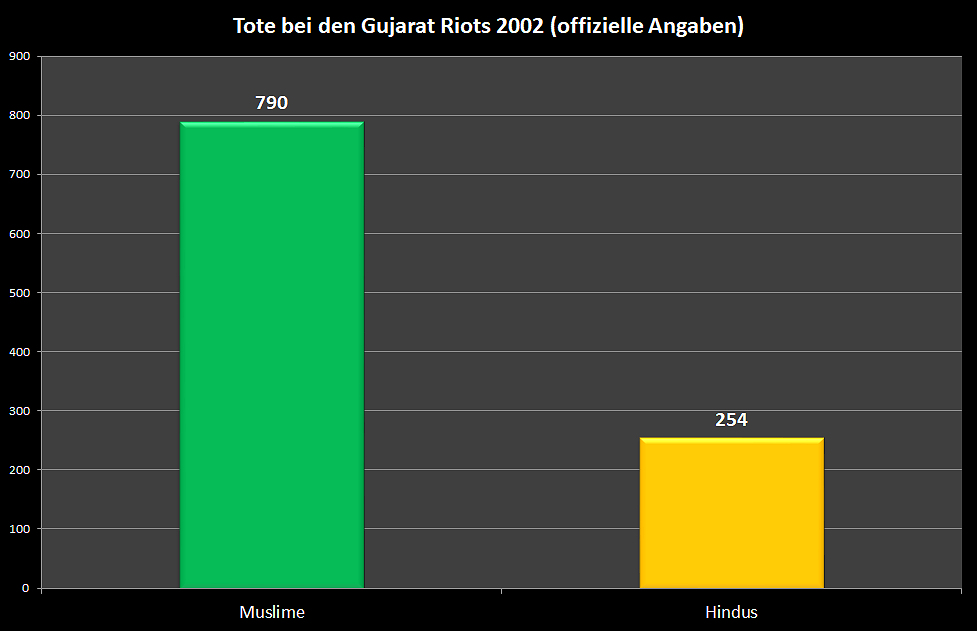
Abb.: Tote bei den Gujarat (Gujarati: ગુજરાત) Riots 2002 (offizielle
Angaben). Dazu kommen über 2500 Verletzte
[Datenquelle:
https://en.wikipedia.org/wiki/2002_Gujarat_riots. -- Zugriff am
2018-03-01]
So wie es vor Gujarāt schon seit langem kommunale Randalen gab, geht es nachher weiter. Als Beispiel diene das Jahr 2012:
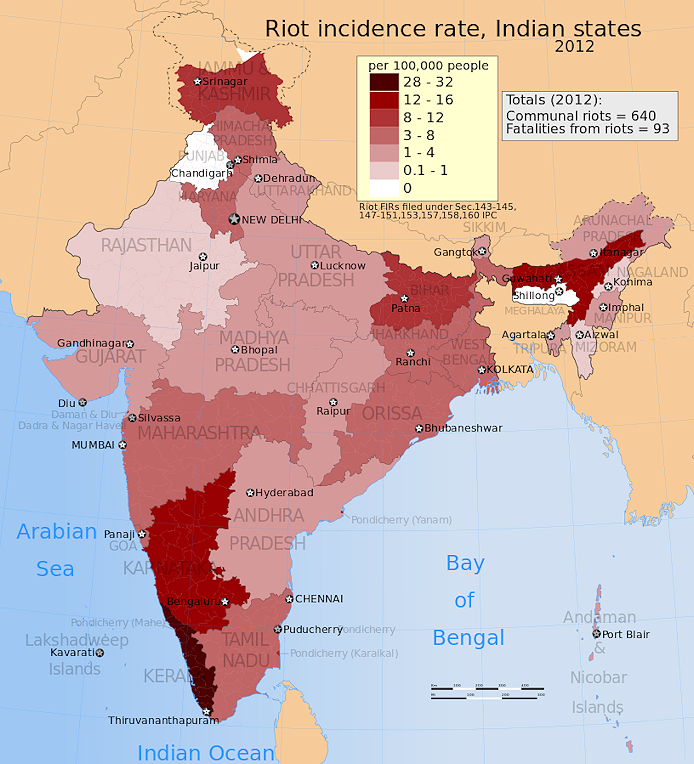
Abb.: Communal riots in den einzelnen Staaten pro 100.000 Einwohner, 2012
[Bildquelle: M Tracy Hunter/Wikimedia. --
CC BY-SA 3.0]
Der politische Flügel des Hindunationalismus, die BJP kann ab 2014 sowohl in den einzelnen Staaten als auch auf nationaler Ebene teilweise große Erfolge verbuchen:
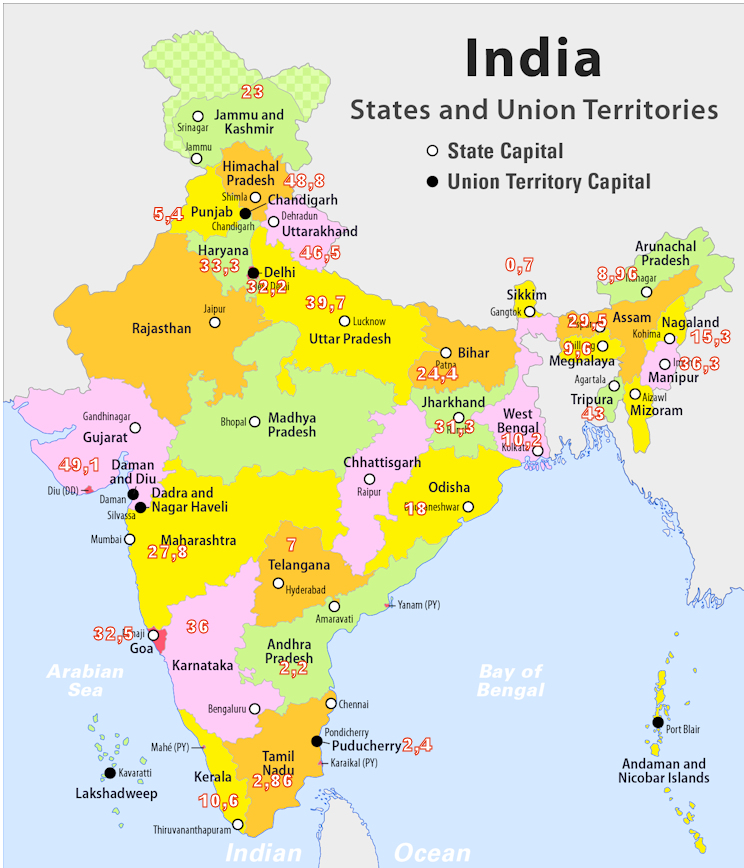
Abb.: Ergebnisse für die BJP Bei Regionalwahlen 2014 bis 2018-06 (in Prozent der
abgegebenen Stimmen)
[Bildquelle: Maximilian Dörrbecker (Chumwa)/Wikimedia. --
CC BY-SA 2.5]
Besonders eindrucksvoll ist der Wahlsieg bei den Wahlen 2014 zur Lok Sabhā (Hindī: लोक सभा), dem Unterhaus des gesamtindischen Parlaments. Hierbei gewinnt die BJP fast 52% der Sitze. Narendra Modī (Hindī: Gujarati નરેંદ્ર દામોદરદાસ મોદી, 1950 - ) wird Ministerpräsident.
Abb.: Sitzverteilung in der Lok Sabha (Hindi: लोक सभा)Legende:
Bharatiya Janata Party (BJP)Telugu Desam Party (TDP)
Shiv Sena (SS)NDA minority parties, including:
- Pattali Makkal Katchi
- Shiromani Akali Dal
- Lok Janshakti Party
- Rashtriya Lok Samata Party
- Apna Dal
- Swabhimani Paksha
- All India N.R. Congress
- National Peoples Party
- Naga People's Front
United Progressive Alliance (UPA)
J&K National Conference (J&KNC)Nationalist Congress Party (NCP)
Indian National Congress (INC)UPA Minority parties, including:
- Rashtriya Janata Dal
- Indian Union Muslim League
- Kerala Congress (M)
- Jharkhand Mukti Morcha
Unaligned regional parties
Communist Party of India (Marxist) (CPM)Communist Party of India (CPI)
All India Anna Dravida Munnetra Kazagham (AIADMK)Biju Janata Dal (BJD)
Samajwadi Party (SP)Janta Dal (United) (JD(U))
All India Trinamool Congress (AITMC)Independents and others
Nominated (NOM)Vacant seats
[Bildquelle: Nick.mon for 2012 version, NikNaks for 2014 edition/Wikimedia. -- CC BY-SA 3.0]
Bei den Wahlen 2019 zur Lok Sabhā wird die Vormachtstellung der BJP bestätigt.
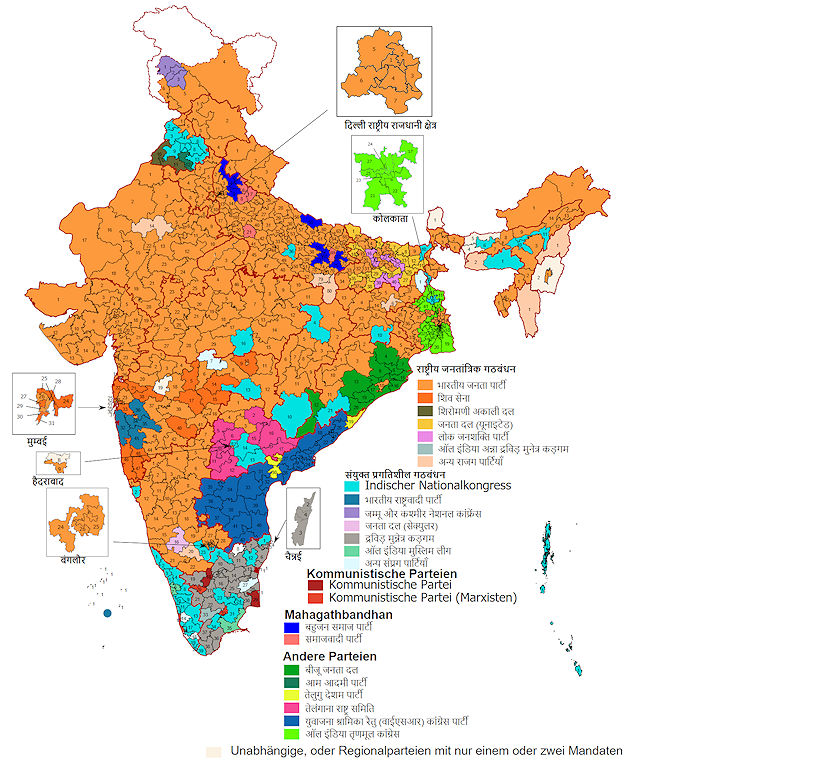
orange: Hindu-nationalistische Parteien
[Bildquelle: Diverse Autoren/Wikimedia. --
CC-BY-SA 3.0]
Indien wird Safran-farbig!
Wollen wir all das Gesagte in einem weiten theoretischen Zusammenhang sehen, gibt es m. E. keine bessere Beschreibung als die des schon am Anfang genannten Max Weber:
"Statt dessen ist hier noch etwas näher darauf einzugehen, daß die Idee der »Nation« bei ihren Trägern in sehr intimen Beziehungen zu »Prestige«-Interessen steht. In ihren frühesten und energischsten Äußerungen hat sie, in irgendeiner, sei es auch verhüllten Form, die Legende von einer providentiellen »Mission« enthalten, welche auf sich zu nehmen denen zugemutet wurde, an welche sich das Pathos ihrer Vertreter wendete, und die Vorstellung, daß diese Mission gerade durch die Pflege der individuellen Eigenart der als »Nation« besonderten Gruppe und nur durch sie ermöglicht werde. Mithin kann diese Mission – sofern sie sich selbst durch den Wert ihres Inhaltes zu rechtfertigen sucht – nur als eine spezifische »Kultur«-Mission konsequent vorgestellt werden. Die Überlegenheit oder doch die Unersetzlichkeit der nur kraft der Pflege der Eigenart zu bewahrenden und zu entwickelnden »Kulturgüter« ist es dann, an welcher die Bedeutsamkeit der »Nation« verankert zu werden pflegt, und es ist daher selbstverständlich, dass, wie die in der politischen Gemeinschaft Mächtigen die Staatsidee provozieren, so diejenigen, welche innerhalb einer »Kulturgemeinschaft« (das soll hier heißen: einer Gruppe von Menschen, welchen kraft ihrer Eigenart bestimmte, als »Kulturgüter« geltende Leistungen in spezifischer Art zugänglich sind) die Führung usurpieren: die »Intellektuellen« also, wie wir sie vorläufig genannt haben, in spezifischem Maße dazu prädestiniert sind, die »nationale« Idee zu propagieren. "
[Max Weber <1864 - 1920>: Wirtschaft und Gesellschaft. -- 1921/1922. -- Kapitel VIII, § 5: Nation. -- Online: Weber, Max, Grundriß der Soziologie, Wirtschaft und Gesellschaft, Zweiter Teil. Die Wirtschaft und die gesellschaftlichen Ordnungen und Mächte, Kapitel VIII. Politische Gemeinschaften, § 5. Die »Nation« - Zeno.org]
Bitte durchdenken Sie diesen Text in Ruhe. Er ist es wert.
Wie der Titel des Vortrags sagt, war dies nur eine Einführung in Hindutva. Ich musste aus Zeitgründen vieles, auch Wichtiges auslassen. Wenn sie sich vertiefen wollen, finden sie viel Material und weiterführende Quellen - viele Teile zum Puzzle Hindutva - auf Tüpfli:
Wer sich mit Indien beschäftigt, sollte unbedingt Hindutva im Auge behalten. Eine gute Möglichkeit dazu ist Twitter:
Hindutva Watch
@Hindutva__watch
Ich hoffe, dass mein Vortrag Schnupftabak für ihr Gehirn war. Danke!